Sophisticated
- thesophisticatedpig
- Jan 18, 2019

11 Stops (YUM!) Self Guided Food tour of Chinatown, NYC and parts nearby.
The following is the first food tour that I put together from online research. We have taken it twice and modified the results based on our tastes. If you start out at 11:30AM when the first shop opens, it should take you most of the afternoon to complete. Enjoy. When we head into NYC from New Jersey we park in Jersey City by the Grove Street Path station and then take the Path over to the Christopher Street stop and walk East to begin the tour. At the end of the tour we head back to Christopher Street. Its a nice long walk for the day. You will probably get in 5 or 6 miles of steps in during the day.
Some thoughts before going on any food tour.
1. Go with people who like food! It may seem obvious, but if you are picky and only eat chicken fingers, don't go on a food tour. You will be bored. Find people with a passion for food and you will all have a much better time time.
2. Try new things. Get out of your comfort zone and try things that you may not like. Durian flavored ice cream for instance...
3. Use these tour notes as a guide, not a edict. If something else catches your eye during the day's exploration, go explore it. The sophisticated pig wont mind.
4. Bring a plastic knife and fork to help eat things on the street.
Stop 1: Prince Street Pizza – 27 Prince Street (opens at 11:30)

What to Order: The standard slices are fine, but what you really want is the Spicy Pepperoni, a Sicilian-style slice topped with a spicy tomato sauce, house-made fresh mozzarella, and natural casing pepperoni. The slice is big enough to share (there are 10 more stops on the tour). If you brought a plastic knife with you, cut it into sharing size pieces. Chris and I share one slice without a knife, we just switch back and forth taking yummy bites. Careful of burning the roof of your mouth at the first stop. The pies are so popular that you always get a slice that is literally right out of the oven.
Stop 2 Taïm – 45 Spring Street (opens at 11AM)

Once you've had your slice, walk south down Mott street for one block to Spring Street and and then turn right and go west for one block to the corner for Tiam. Here you can get excellent falafel. Ask for a sampler plate of falafel, its not listed on the menu, but if you ask an experienced person behind the counter, you will get a sample of the different available falafels for a little over 4 bucks.
Stop 3: Despana – 408 Broome Street (seats and a bathroom)

Continue to head south to 408 Broome Street for on of the best purveyors of Spanish delicacies in New York. Lots of samples are out to taste. Order any of the Hot or cold tapas available at the counter in the rear of the store. The octopus flatbread is one of my favorites. Also note that most Saturdays in the summer they will have their Paella afternoons starting at 1PM. You have to get in line to reserve a plate of Paella, but its awesome.
Stop 4: Golden Steamer - 143A Mott Street

Head east back to Mott street and then south to Golden Steamer for a Steam bun. They are big enough to share and come with a variety of filling. BBQ Pork is my choice. Very inexpensive, $1 each. Its not my favorite on the tour, but they are something I can only get fresh on the tour or in a specialty Asian Food market.
Stop 5: New York Mart – 128 Mott Str

Time for a break from eating. Continue south down Mott street and head in to this bustling market. When you step in, you will realize you are not in any ordinary grocery store. Anything Asian you can imagine and lots of stuff you can't imagine are sold here. Squeeze thru the crowds and browse the seafood department to see what fresh fish is about. You can get live turtles and frogs if you care to. If you want, go to the roasted pork/duck stand and buy some by the pound, its wonderful. Or just browse the different departments while you digest some for the next stop.
Stop 6: Shanghai Heping Restaurant – 104 Mott Str

Continue south on Mott street to get the the Shanghai Heping Restaurant. They have amazing soup dumplings. Go inside and get an order to go. Although you can eat inside, they have a minimum per person so get one appetizer order of dumplings to go. We split one order between 4 of us. The place has steps that you can sit on and enjoy your dumplings outside. To eat a dumpling, bite a small whole in the dumpling, slurp out the yummy broth, and then eat the rest of the dumpling.

Stop 7: Tai Pan Bakery – Canal between Mott and Mulberry (has seats)

Continue south on Mott street until you get to Canal street. Then cross to the south side of Canal and go west for 1/2 a block to reach the bakery. Chinese baked goods are not as sweet as US bakeries. I always enjoy one of the mini tarts, but everything looks amazing in the store. Have a seat as you eat your choice and rest a bit.
Stop 8: Chinatown Ice Cream Factory - 65 Bayard Street between Elizabeth and Mott Streets
Go back to mott street and head south until you reach bayard street heading off to the left. one half a block down bayard street is chinatown ice cream factory. at $5 a scoop, it’s a bit pricey, but they have unusual flavors like ginger, wasabi, dragon fruit, durean, and black sesame seed. they have more traditional flavors, but why not experiment. you wont see these flavors many other places., stop 9: the crown rooftop bar – 50 bowery str. (bathroom).
Time to plop down, relax and have a drink. Head east to 50 Bowery Street. Go to the Crown Hotel and take the elevator up to the rooftop bar and enjoy a seat and the views of lower Manhattan's skyline. You might think its touristy, but face it, you are a tourist on a food tour.

Stop 10: East Dumpling – 46 Eldridge

We now can walk about 4 blocks to East Dumpling on Eldridge street. The place looks like a hole in the wall, but they make great pan fried dumplings. Order 10 for 3 bucks and enjoy between your fellow foodies. Note that they only speak Chinese or Spanish here. Some hand signals and pointing may be in order.

Stop 11: Vanessa's Dumpling House – 118 Eldridge (seats and bathroom)
Last, but not least, head north on eldridge to get to vanessa's dumpling house. we are not here for the dumplings, but for the stuffed sesame pancakes. the peking duck sesame pancake is awesome. its hard to explain the dish, but imagine a sesame crusted focaccia that has been split in the middle and stuffed with peking duck fixings. each portion is the size of a pizza slice. pure heaven. chris and i split one because by this point, i cant eat much more..

The tour is done, and I hope you enjoyed it. At this point we head back to the Path train to return to New Jersey. Dinner that night would usually be something very small....
Recent Posts
Amazing Culinary Vacation in Spain
Around the world with a Brooklyn Food Tour!
Time for a Harlem NYC Food Tour!
It was a wonderful trip! Thank you both for taking us :)
/cdn.vox-cdn.com/uploads/chorus_image/image/59386239/PELL.1523656742.jpeg)
Filed under:
A Highly Historic, Incredibly Tasty Food Tour of Manhattan’s Chinatown
Spend an afternoon gorging on cheap eats, from 25-cent dumplings to green tea ice cream
Share this story
- Share this on Facebook
- Share this on Twitter
- Share All sharing options
Share All sharing options for: A Highly Historic, Incredibly Tasty Food Tour of Manhattan’s Chinatown
New York’s Chinatown is home to some of the best affordable eats in the city — and it also happens to be an area rife with history. The neighborhood is ideal fodder for a walking tour with both fantastic food and NYC history. Start at the 15-foot bronze statue of Confucius by Taiwanese sculptor Liu Shih, installed in 1976 to commemorate the Bicentennial. It’s a perfect place to meet your friends and for a Chinatown cheap eats tour to begin. Follow along with this guide; a custom map will escort you.
:no_upscale()/cdn.vox-cdn.com/uploads/chorus_asset/file/10647867/ENY_CheapEats_Logo.jpg)
Begin your journey at the corner of Bowery and Pell Street, where you’ll find a cart that sells Hong Kong cakes. They’re little eggy treats cooked in a waffle iron that break apart for easy sharing at 15 for $1.25. Snack on those to kick things off.
One block south is the start of Doyers Street. At only one block long, it is one of the shortest streets in the city, but also one of the few with a bend in the middle. Proceed along Doyers to the bend in the road. On your left is Nom Wah Tea Parlor , founded in 1920, making it the oldest eating establishments in Chinatown. It looks every year its age, even though it was extensively restored a couple of years ago and has become wildly popular. The dim sum (small snacks based on dumplings and noodles, taken with tea) is pretty good.
But the bend in Doyers directly in front of you has long been known as the Bloody Angle. During the Tong Wars around the turn of the 20th century, when two rival gangs called the On Leongs and Hip Sings struggled for supremacy, it was the site of many assassinations, often accomplished with small hatchets. A narrow passageway that went from this corner to Mott Street permitted the murderers to escape. Though the corner has been extensively altered since then, see if you can figure out where the entrance to the passageway was.
Emerge from Doyers and turn left onto Pell Street, one of the oldest thoroughfares in Chinatown, which began to assume a separate identity from the rest of the city in the 1860s, but still consisted mainly of four streets for over a century (Mott, Doyers, Pell, and Bayard). Proceed to Mott Street, turn left, and find yourself in the middle of the most ancient part of Chinatown.
:no_upscale()/cdn.vox-cdn.com/uploads/chorus_asset/file/10660215/NOM_WAH_2.JPG)
As you proceed southward, on your right is tiny Mosco Street, a very short descending alleyway that was at the heart of the hardscrabble Five Points neighborhood — the area’s old name — prior to the Civil War. It still retains some of its 19th century feel. On the left at the top of the hill is a shed beloved of generations of kids that once dispensed the original Hong Kong cakes. On the right is the Church of the Transfiguration, the oldest Catholic church building in New York City, dating to 1801.
As you descend the hill on Mosco, you’ll see a store called Fried Dumpling , really just a rough hewn stall. It was the second, and now only, remaining branch of Fried Dumpling, which revolutionized cheap eats when it opened in 1999 on the Lower East Side, selling five pork pot stickers for a dollar, an amazing bargain. The menu remains slim, with only five items, and you can watch the dumplings being made. Stop for a serving of five, now $1.25.
:no_upscale()/cdn.vox-cdn.com/uploads/chorus_asset/file/10660225/DOLLAR_DUMPLINGS.JPG)
Labor back up the hill and turn right on Mott. Directly on your right is Hop Kee at 21 Mott and then the basement original of Wo Hop at 17 Mott. The latter, down a steep red flight of stairs, is the second oldest restaurant in Chinatown, founded in 1938. It also serves one of the city’s best evocations of early Chinese-American cuisine, first developed during the days of the Gold Rush and later during the building of the first Transcontinental Railroad, when immigrant Chinese cooks were faced with recreating classic dishes from back home using the limited materials at hand.
Later, it evolved into a cuisine made to appeal to contemporary American tastes, spawning neighborhood Chinese restaurants in every corner of the country, many of which still exist. At Wo Hop you can thrill to such antique dishes as chow mein, egg foo yung, pepper steak, and chop suey — said to be the original Chinese-American dish. Eating a meal at Wo Hop would not be a bad idea. When you’re done, dart across the street to Wing On Wo & Co., which, according to the metal awning, sells “Oriental Gifts.” It has been run by the Lum family since the 1890s, making it the oldest retail establishment in Chinatown. Inside, find a framed photo of what the place looked like when it opened.
:no_upscale()/cdn.vox-cdn.com/uploads/chorus_asset/file/10660233/WO_HOP.JPG)
Wo Hop; Wing On Wo & Co.; Chinatown Fair Video Games
Indeed, Chinatown has always been a tourist destination, and Mott Street is still filled with establishments that sell paper fans, silk pajamas, bamboo back scratchers, and other old-fashioned souvenirs aimed at the tourist trade, things that symbolized China long ago for customers that had never been there and couldn’t imagine going.
Now turn around and walk north up Mott Street toward Canal Street. On the left at 41 Mott find Golden Fung Wong Bakery , one of the oldest bakeries in Chinatown. The timeworn interior alone is worth a visit, but it’s also worth sampling its specialty, hopia — little round pastries that are flaky on the outside and gooey on the inside. They originated in China and spread to the Philippines, a testament to the Chinese diaspora across Southeast Asia.
A further testament is found at the corner of Bayard and Mott, where the long-running Bo Ky restaurant serves what is known as Teochew cuisine, a form of Chinese food heavily influenced by the cooking of Vietnam, Malaysia, and Thailand. It’s another great place for a meal, especially if you get the Teochew duck, fried shrimp rolls, or fish ball noodles. On the other side of the intersection, you can spot the venerable Chinatown Ice Cream Factory , where the flavors run to lychee, green tea, and mango.
:no_upscale()/cdn.vox-cdn.com/uploads/chorus_asset/file/10660241/BO_KY.JPG)
Now, continue north on Mott till you reach Canal Street, admiring the mix of shops and restaurants along the way. On the southwest corner at Canal and Mott is the stunning On Leong Tong Building. It’s named after the gang that fought in the Tong Wars — the one mentioned above that was active on Doyers — and its pagoda roof, broad balconies, and red pillars are representative of a style of architecture known as Chinese Modern, promulgated by Poy Gum Lee. He was born in Chinatown in 1900, immigrated to Shanghai in his youth, and returned to New York City just after World War II, merging Art Deco and Chinese temple architecture in his revolutionary designs.
:no_upscale()/cdn.vox-cdn.com/uploads/chorus_asset/file/10660223/ARCHITECTURE.JPG)
Head west on Canal until you reach Baxter Street, two blocks distant, passing another Hong Kong cakes cart. Once known as the poorest blocks in the Five Points district before the Civil War, Baxter Street is home to the Tombs, Manhattan’s most notorious jail, but also to a string of Vietnamese cafes that began appearing in the ’70s after the United States lost the Vietnam War. They are run by Chinese-Vietnamese immigrants who had mainly lived in the Mekong Delta southwest of Saigon (now Ho Chi Minh City). Stop for a steaming bowl of pho, and then proceed south to Bayard Street, turn left, and head over to Mulberry Street.
Mulberry, too, eventually became a Chinatown street, but remains one of those least visited by tourists. It also boasts a few Vietnamese restaurants, and some small groceries, butchers, and fish markets.
The penultimate stop on our Chinatown tour is two lines of outdoor fruit vendors on either side of Mulberry Street running south from Canal Street. There find discounts on such exotica as dragon fruit, fresh lychees and longans, and furry red rambutans. Stock up!
:no_upscale()/cdn.vox-cdn.com/uploads/chorus_asset/file/10660259/MOTT_STREET.JPG)
The last stop makes a nice conclusion to our tour: the Museum of Chinese in America at 215 Centre St. will fill in more details of Chinatown’s development, and how it was contingent on the repugnant behavior of the American government, which strangled Chinese immigration during much of the 19th and 20th centuries via such legislation as the Chinese Exclusion Act (1882).
With the repeal of that act and other restrictions, Chinatown began to grow, ballooning over ten times by the end of the 20th century, so that now it extends through much of the original Lower East Side and parts of Little Italy, almost to Houston Street. But that is a tour best left for another day.
Fried Dumpling
The ultimate guide to nyc’s cheap eats.

(917) 628-4427
THE CHINATOWN EXPERIENCE

CHINATOWN FOOD TOURS
Join me on my walking food tour through Manhattan's Chinatown! We'll weave through the streets discussing the evolution of this historic area while tasting three of my neighborhood favorites. We will also visit Chinatown's largest food market and I will provide insights and explanations on the practices of Chinatown's businesses.

About Chad!
I'm a chef with the bulk of my experience in New York City fine dining. My interest in Chinese cuisine grew to passion after moving to Manhattan's Chinatown several years ago. This neighborhood became my true home as I built relationships with local small business owners over the years. I’m passionate about sharing my love for Chinatown along with its food and history.

BE IN TOUCH
Let me know what I can do for you including questions regarding special tours or dietary restrictions.
New York Chinatown, Walking Tour
New york self guided walking tour, food tour, attractions, things to do, use the new york walking map & attractions guide to visit chinatown, chinatown walking map of attractions and food tour stops.
Follow the walking map and attractions guide and food tour stops for things to do in Chinatown New York. Visit attractions and well known places to eat, use the INTERACTIVE or PDF Guide
Download interactive walking map of attractions and food stops HERE
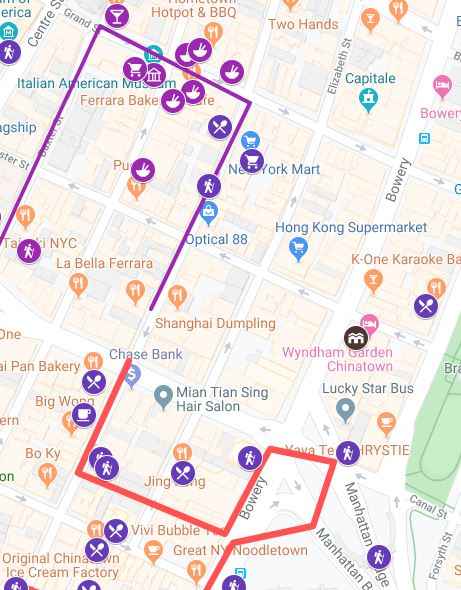
Download PDF walking map of attractions and food stops HERE
New york attractions: chinatown history.
An anti-Chinese movement fueled by anxiety over jobs drove the population who worked on the railroad to this section of New York. The population in Chinatown grew from 150 in 1859 to 2000 in 1870. The core streets for settlement by the Chinese were Mott, Pell and Doyer Streets. They joined other immigrants in the area mostly freed African Americans and the Irish
At this time the Chinese were barred from citizenship which led to their own internal support structure such as medical, housing and jobs. Much of that was coordinated through a group of established Chinese merchants who spoke English and established the Chinese Consolidated Benevolent Association in the 1880’s. This was their informal quasi government allowing for a self-supporting and self-segregated community
This umbrella provided for three specific groups;
- the fongs were those from similar districts in China,
- the tongs (gangs) were business or trade associations and
- the family clan association ie: Lee, Wong, etc
The immigration laws did not allow for family reunification and so the population was dominated by men that came to America to work on the railroads leaving behind their wives, mothers, sisters, etc. In 1900 there were 4000 men and 36 married women in Chinatown. They were not able to marry American women as the restrictive laws resulted in the American women losing citizenship if she married a Chinese man. The men, unhinged and without female partners, turned to gambling, prostitution and the opium trade
In 1965, the immigration restrictions were lifted and a wave of chines immigrants came to New York. In 1980 New York Chinatown had the largest Chinese population in the US. Today the area has over 60,000 Chinese population, the largest in the western hemisphere
New York Chinatown Attractions: Mahayana Temple Buddhist Association
Located close to the Manhattan Bridge arch and colonnade the of Mahayana Temple, it is the oldest and largest Buddhist temple on the east coast. The entrance is flanked by two golden lions as a sign of protection. It has the largest Buddha statue at 16 ft. sitting on top of a lotus flower in the main room. You will also find chairs and place cushions to kneel. The Mahayana Temple walls are lined with artwork that depict the life of Buddha. The temple is used by locals who come by to light incense, pray or make a donation. It’s a temple so you will have to dress appropriately by covering your shoulders and knees.
New York Chinatown Food Tour: Wah Fung on Chrystie
Huge portion, noodles or rice with a variety of toppings including duck. They don’t skimp on the toppings so come with an appetite. Grab your meal and walk across the street to eat at one of the benches in Chrystie Park. Chrystie park is a popular park where you will see generations of families some of whom are playing mahjong, or with their kids on the basketball court or on the playground
New York Chinatown Food Tour: Shu jiao fu Zhou
Next door to the popular Vanessa; I found Vanessas good but caters more to the tourists so you will have pleasant staff, great customer service, nice ambience and higher prices. Try the hand-pulled noodles at Shu jiao fu Zhou and their dumplings; both are really good and very reasonable priced.
New York Chinatown Attractions: Manhattan Bridge Arch and Colonnade
The bridge was designed by Carrie and Hastings. Construction started in 1901 and was completed in 1909. It connects Canal Street in China Town to downtown Brooklyn. The entrance is distinguished by the ornate arch and colonnade. The colonnade is similar to Bernini colonnade in Saint Peter’s square in Rome where the colonnades seem to reach out in a wide hug. The arch and colonnade became a New York City landmark in 1975. The bridge is the third suspension bridge that crosses the east river. The first one that was built was the Brooklyn Bridge between 1867 and 1883 and then the Williamsburg Bridge between 1896 and 1903.
The bridge is easily walkable and has a bike path, however it is not as popular as the Brooklyn Bridge to the south. The walkways are on the outer edge and therefore those who cross the Manhattan Bridge are rewarded with sweeping views of the harbor not seen on the Brooklyn Bridge in the background. Keep in mind that the Manhattan side bridge does have the Subway that goes across it so it could be noisy at times; on the other hand you could use the train to cross the Manhattan Bridge and you could get a view of the harbor albeit a moving view. My suggestion would be to cross the Manhattan Bridge to get to Brooklyn and then once you get to the Brooklyn side walk over to the Brooklyn Bridge on the way back to Manhattan. You should easily be able to put this into your google maps and use the offline map
New York Chinatown Attractions: HSBC Bank – Citizens Savings Bank
Located on the southwest corner of Canal and Bowery Street the former Citizens Savings bank is a visible landmark for those coming off the Manhattan Bridge into Chinatown. It was built in 1924 and was designated as an official city landmark in 2011. Facing Bowery, it towers over the shops and restaurants in the area. The imposing 110 foot tall building was meant to reassure its customers on the stability of the bank. The focal point above the entrance is a “broken” clock flanked by a sailor, an eagle and an Indian. Two beehives sit on either side of the clock. The sculpture was designed by Charles Keck while the building was designed by Clarence Brazer.
New York Chinatown Attractions: The Bowery
The first settlers were ten freed slaves and their wives who in 1654 built cabins and farms near what is Chatham Square today. The Dutch arrived in the area in the late 1600’s. The name is derived from the Dutch word “Bouwerji” meaning farm. This street was occupied by Dutch farmers in the 17th century. Originally called Bouwerji Road it was on the outskirts of the city and connected the large family farms. Continued growth of the city pushed the city boundaries outwards and by the early 1800’s “Bowery Lane” as it was then known, became part of the city and was losing its farming roots. In the 1990’s a movement to revive and gentrify the neighborhood began. In the 1800’s it became an upscale theater and entertainment district and by the 1900’s it had declined significantly becoming a seedy neighborhood and center for prostitution. In 2011 the area was registered as the Bowery Historic District with the State of New York. With the designation came access to financial incentives encouraging property owners to restore rather than destroy old buildings. The Historic district starts at Chatham Square on Bowery and ends at Astor Place
New York Chinatown Attractions: Confucius Plaza
A federally subsidized housing cooperative with 762 apartments built in 1975, it was Chinatown’s tallest building and was occupied by mostly Chinese American residents. The apartment complex also houses a public school (kindergarten to grade 8), day care center, stores and a small community space in the center used as a meeting place or to hold events. Just outside of the complex is the bronze statue of Confucius donated by the Chinese Consolidated Benevolent Association
New York Chinatown Attractions: Confucius Statue
Located in front of Confuscious Plaza, the bronze 15 foot statue of the great Chinese Philosopher was designed by Liu Shih. It was donated to the Chinese Consolidated Benevolent Association in 1976 by the Taiwanese Republic of China as a symbol of the community to commemorate the bicentennial of the United States. The statue is one of two statues on Bowery. The other one is at Chatham Square on Bowery and is dedicated to Lin Ze Xu
New York Chinatown Attractions: Chinese Consolidated Benevolent Association
Chinatown learned to rely on its own community to support itself in the early days because of racial immigration and backlash from the mainstream communities threatened their economic future. It was founded in 1883 to help new immigrants who spoke very little English, navigate daily life in New York. In its early days it also functioned as quasi-governmental agency within the community helping with socials, economic and financial issues including dispute resolution. It was started by a few people who spoke English to help those moving into the community. Services included finding health care, housing, jobs, skills training and food. New immigrants would contact the association and receive assistance to navigate daily life
New York Chinatown Food Tour: Jing Fong Restaurant
A popular banquet hall and restaurant opened in 1978 that can accommodate 800 people and is a popular wedding venue. They serves dim sum daily with limited variety after 3pm and increased varieties on weekends. Dim sum is a small meal on a small plate with items such as steamed buns, seafood, and other treats. Servers circulate and patrons remove food off the circulating carts. The waitress keeps track of what is taken off the cart and you pay for what you remove from the cart. It is ranked as one of the top dim sum location in New York
New York Chinatown Food Tour: Tai Pan Bakery
Opened in 1990, it serves fruit tartlets, custard tarts, pork buns, sweet and savory baked goods, and it’s one of the popular and well known bakeries in Chinatown. Frequented by locals, you will find elderly women drinking tea and socializing while others grab and go with bags full of bakery items to take home
New York Chinatown Food Tour: Ten Ren’s Tea and Ginseng Co.
A global tea shop founded in 1953 by Taiwanese Ray Ho Lee of the Ten Ren Group of Companies. It has a great variety of teas and is a mecca for tea connoisseurs. They will allow you to sample teas before you purchase
New York Chinatown Attractions: Eastern States Buddhist Temple
Annie Ying noticed that many elderly immigrants were on the streets with nothing to do so she opened the back of husband James’s store located on Broadway. This gave them a place to gather and socialize. She eventually opened the basement to them as the socialization took on a more religious purpose. In 1962 the activity moved to 64 Mott Street where she opened the Eastern State Buddhist Temple. It is the oldest Buddhist temple on the east coast. 25 years later, to celebrate her husband’s 83 rd birthday, she opened another location referred to as the eastern campus at 133 Canal Street called the Mahayana Temple . The temple holds weekly services, and provides funeral and marriage services as well as blessings by monks
New York Chinatown Attractions: Most Precious Blood Church
Construction began in 1891, however due to lack of funds, the church was eventually taken over and completed by the Franciscan Order in 1904. Serving the Italian community, the congregation has expanded to include the newly arrived Vietnamese immigrants and is the site of the Vietnamese Arts and Culture Centre. In 2014 the Church came under the administration the diocesan administration due to lack of people in the Franciscan order. It is now part of St Patrick’s Cathedral
New York Chinatown Food Tour: Kam Hing Coffee shop
A favorite for sponge cakes, they are light and fluffy with a crispy top. A variety of flavors are available including pumpkin and green tea, however the favorite is the one labelled “original flavor”
New York Food Tour: Rice Noodle Cart
There is a Rice Noodle cart at 153 Center Street between Canal Street and Walker Street. If you blink you’ll miss it and that would be a shame. It’s an outdoor food cart run by two local women. Check it out on google maps to see the photos so you don’t miss it (type “rice noodle cart center street” in google maps). It is super cheap and super good. Closes at 3:30
New York Attractions: Columbus Park
It’s hard to imagine that such a peaceful location was the site for one of the most violent areas in the US where gangs fought for control, as depicted in the movie Gangs of New York. The City demolished the area including the Five Points intersection where in 1896 five streets converged to one point. Of the original five streets, today there are only three remaining: Anthony become Worth Street, Orange became Baxter Street and Cross became Mosco Street. The purpose of the reconstruction of the area to reduce the violence and gang warfare. Columbus Park was built on the site of the Five Points intersection. Today it is a popular community park that is used by the local Chinese residents. You will find the elderly playing board games such as mahjong, other board games or cards. Grab something to eat and soak in the culture at this park listening to Chinese music on their music boxes or Chinese musicians singing songs or playing traditional instruments. In the morning you will find groups who are doing tai-chi
The Brooklyn Bridge is only a 15 min walk from Columbus Park
New York Food Tour: Tasty Dumpling
Another local favorite is fried and steamed dumplings that serve locals, tourists and business workers in the area. Their specialty is the chive and pork dumpling, however they have a great variety of dumplings including chicken, mushroom, and items such as sesame pancake (local favorite). Great food at great prices!
New York Attractions: The Five Points
The Five Points area is on the site of what is now Columbus Park. Five points was a neighborhood in lower Manhattan with a growing population of immigrants and recently freed slaves who were some of the poorest people in America. Immigrants, in the area included eastern Europeans Jewish immigrants, Italians and the Irish Catholics who were escaping the potato famine. Five Points gets its name from the convergence of several streets to a point with five corners. The streets that were part of the five corners included of Anthony Street (today it is called Worth Street) Cross Street (today it is Mosco Street), Orange Street (which is now Baxter St) and Little Water St which doesn’t exist anymore
In the 1800s this area was the location of a number of gangs and the life here was depicted in the movie “Gangs of New York”. To give you an idea of the kind of life people lived here, the old brewery called Coulthards Brewery which became a landmark, was a housing tenement (tenant) with about 1000 men, women and children along with illegal activities conducted in the brewery such as gambling and prostitution. Five points had highest crime rate in the country and the old brewery saw a murder every single night for 15 years
The squalid conditions led to a disease infested neighborhood and prevalence of cholera, tuberculosis, typhoid, malaria and yellow fever. The poor living conditions continued for about a hundred years, until a photographer went into the area to capture the lives” of the people there. Jacob Rios published his observations in the book “How the other half lives. His book led to an outcry and five points was marked for revitalization. The old brewery was demolished and replaced with missionary housing. The notorious five Points intersection became a park (today it is Columbus park) and dangerous streets with blind corners were rerouted and renamed. Five Points was changing piece by piece and eventually the five points area became part of New York’s history
The revitalization of Five Points began and with it came a new wave of Asian immigrants in the 20th century. So Five Points has just become a part of our ever-growing Chinatown and on the other side of five points you will see federal buildings and courthouses collectively called the civic center
The Brooklyn Bridge is about a 15 min walk from the Five Points area and Columbus Park
New York Attractions: Mosco Street
This was once called Park Street and in the mid 1800’s it was called Cross Street. Today it is known as Mosco Street. It was a five block long street and with the building of Columbus Park it was shortened to one small block. This street was a dangerous location for close to about 80 years. It was the starting point of the famous Dead Rabbits riot on July 4 1857. The riot was between the New York born anti-immigration anti catholic anti Irish Bowery boys and Irish catholic dead rabbits gang (also known as the mulberry boys) led by John Morrissey. Morrissey went on to became a state senator reverently supporting Irish catholic causes. The riot lasted two days and involved 1000 gang members, killing 8 and injuring 10 men. Eventually the New York State militia stepped in to take control ending the riot at 9pm on July 6. In 1982 this street was renamed Mosco Street after Frank Mosco, a well-known community activist who lived on the street. Today it is a narrow one block street between Mulberry and Mott Street. It is all that remains of the five point era
New York Attractions: Church of the Transfiguration
The Catholic Church of the Transfiguration is located on the corner of Mott and Mosco. This is the oldest Roman Catholic Church and was built in 1801 as a Lutheran Church. The church was sold to the Roman Catholics in 1850. It is commonly referred to as the little church around the corner, and known for its inclusivity. It served the newly arrived Italian, Irish and Chinese communities and became a New York City landmark in 1966. There are daily tours or you can look around on your own and enjoy its lovely gardens. Today it serves a mostly Chinese community
New York Food Tour: Fried Dumpling
A Chinatown special, this tiny place has been serving dumplings for decades
This is the place to come and experience bad customer service in a bare bones location, serving great dumplings at a cheap price. If nothing else come for the “angry dumpling lady”. If you really want her to feel the angry, try paying her with quarters. This is a must stop. Get your dumplings and walk across the street to sit on the stairs as you eat your dumplings and watch the stunned tourist faces as they politely try to order
New York Attractions: Mott Street
In the early days, Mott Street was known as Old Street and Wynne Street. Like most streets at the time, it seemed to meander where the landscape took it took it. This is why there are so many bends and curves in Chinatown. The grid structure for roadworks was established much later and roads started to following the typical grid pattern that is still in place today.
Unofficially referred to as the “main street” of China Town, Mott Street runs north to south and is named after Joseph Mott. Joseph was a butcher who also owned a tavern on Mott Street. He provided resources to the rebels during the American Revolution.
Mott has a colorful history starting with its first Chinese settler named Ah Ken. A Cantonese speaking immigrant, he is thought to have arrived in the area in 1858. He kept a small rooming house on lower Mott Street and rented out beds to newly arrived Chinese immigrants. After earning enough money from this activity, he was able to progress from peddling cigars on the street corner to opening his own cigar store called “Park Row Smoke Shop”
In the 19 th century, lower Mott Street was part of the famous Five Points poverty stricken, violent slum neighborhood. It attracted immigrants to the area because of its low cost housing (beds for rent). Wo Kee opened a general store on Mott Street , close to Pell Street, and in the ensuing years Chinese immigrants settled in this area. The immigration laws did not allow for family reunification and the Chinese males who worked on the railroads settled in this area. The mostly male population became involved with prostitution, gambling, drugs, loans, racketeering (protection fees) and the area was dominated by Chinese gangs called tongs.
The most famous of those was the On Leong Tong (gang) who legitimatized their business through a corporation called the On Leong Chinese Merchants Association. They terrorized and controlled Mott Street for decades. Eventually the strict immigration laws were lifted and family reunification allowed for influx of immigrants into Chinatown. Today Mott Street is lined with restaurants, bubble tea and gift shops catering to the tourists
New York Attractions: Quong Yuen Shing General Store (General Store on Mott Street)
Located at 32 Mott Street, it opened in 1892. It is the oldest grocery store in Chinatown owned by the Kee family. The store lies at the heart of Chinatown and at that time it served more than just groceries. For over 100 years it was the social center of the Chinese community where you could purchase groceries or get assistance with writing letters back home. Rooms at the back of the store were converted to bunk beds supplying temporary housing.
The products at the Quong Yuen Shing General Store has changed over the years from groceries to household items to medical herbs to silks and satin. However the interior changed little, using the same counters and wooden shelving for the expanded product line. The store closed after 9/11. The effects of 9/11 caused a disruption in traffic patterns into china town which greatly affected many business including this one. The financial impact due to a slowdown in customers resulted in the closing of the store in 2003. Chinatown is slowing recovering and new owners have since opened up at this locations as a gift shop
New York Chinatown Attractions: Aji Ichiban – Candy Shop
Located on Mott Street, the store has a large variety of dried food items, both sweet and savory. Founded in Hong Kong in 1993, there are over 150 franchises around the world. You will find salty and sweet snacks, dried fruit, jerky, traditional eastern items like wasabi seaweed and exotic candies. You can sample the items before you buy
New York Chinatown Attractions: Pell Street
Just around the corner from Mosco Street and bordering Mott Street is Pell Street. A favorite among film companies and photographers as it depicts the Chinatown ambiance. This piece of land was owned by the Pell family and Hill Street was built in 1776. It was the location of many gang fights, opium dens, gambling and prostitution saloons controlled by Chinese gangs. Two most famous ones were the On Leong and Hip Sing Tongs. Two of these were located at 11 Pell Street and 13 Pell Street. Today it is lined with hairdressers, salons, barbershops and is known as barbershop alley. Workers from the barbershop and hair salons stand outside beckoning you to come in and just like the children following the pied piper I followed one of them into the salon and had my haircut. A very interesting experience and a great haircut
New York Food Tour: Vegetarian Dim Sum House
If you are looking for a vegetarian option and want to experience Dim Sum in chinatown, this is the place to go. Located on Pell Street, dishes include turnip cakes, rice rolls and spinach fried dumpling. You will also find gluten free choices, tofu and mock meats such as duck and beef.
New York Chinatown Attractions: Doyers street
From Pell Street you can head to Doyers street. The street is named after the Dutch Immigrant Hendrik Doyer who owned the land on which this street is built. It was also the site of his pub and distillery. Today that spot is the site of the United States Postal Service. What’s unusual about the street is the angles that the road makes. There are two separate turns on the street making a zigzag so you are changing directions two different times as you meander down Pell Street to Bowery
A 200 ft. long street, Doyers street was known as bloody angle because of the 90° angle it makes on the street creating a blind spot prime for ambushes, shoot-outs and murders. With the blind spot it became a place where many Chinese gang wars erupted spilling blood, hence the title “bloody angle”. Like Pell Street in the early 1900’s, Doyers had become one of the most violent streets in history. This was where two rival Chinese tongs (gangs) the hip Sing tong and the On Leong tong fought for dominance. They were also tunnels connecting the street to many of the buildings for a quick escape. One of these tunnels is near the Nom Wah Tea Parlor next to the coco fashion shop.
New York Chinatown Attractions: 5-7 Doyers Street (the former Chinese Theater)
A popular Chinese opera House from the late 1800’s, it opened its doors in 1893 to serve the growing Chinese Community. A most violent gun battle in front of the theater in 1901 between the Hip Sing tong (gang) and the On Leong tong (gang) resulted in four people dead. The theater never recovered from the violent reputation of the street and eventually had to shut down in 1901.
New York Food Tour / Attractions: Nom Wah Tea Parlour
New York’s first dim sum restaurant is located on the street called Nom Wah Tea Parlour. The building has been here since the 1920s. First owned by the Chou family, it was sold to Wally Tang who started working there at 17. Its interior has hardly changed and while it may not be the best dim sum place today, it is very authentic.
New York Food Tour: Tasty Hand Pulled Noodle
Tasty handful noodle is a small unassuming place near the end of Doyle Street just before you Bowery. The staff are friendly. It is an open kitchen with nothing fancy. With the open kitchen concept, you can watch the guys at the counter pulling and manipulating the dough into long noodles. Most of the people in there are locals. You won’t see a lot of tourists and the food is brilliant. Just top with fresh cilantro and scallions and it’s the perfect spot for a quick lunch. You can get any kind of toppings with your noodles but be sure to order the hand pulled noodles. The noodles are light and not doughy or heavy and you can get them pan fried or as part of a soup bowl. Try the steamed dumplings; you can’t go wrong here, great cheap food. Cash only.
New York Attractions: Edward Mooney House
At the corner at the south west corner of Pell Street and Bowery, you’ll find the Edward Mooney house. A tall red brick building, it is the oldest building in Chinatown and one of the very few remaining from 18th century. The building was completed in 1789 by Edward Mooney, a butcher, and even survived the great fire of 1835. The architecture is preserved from that time including the small Georgian windows and the wooden door frame. It started as a townhouse and has had a variety of functions in the past including a restaurant, a pool hall, a hotel and pub but today it is the location of a bank
New York Food Tour: Mei Lai Wah
A local favorite, no frills, simple bakery with great food at cheap prices. The décor is very basic and has a small eating area with several booths which are usually occupied. They are known for their baked pork buns; Try cha shu bau which is an absolute favorite. Pick up baked or steamed buns and options for vegetarians are available such as the lotus paste steamed buns. Do what New Yorkers do, grab and go. The Chinatown ice cream factory is just across the street
New York Food Tour: The original Chinatown ice cream factory
A family owned shop that’s been operating for four decades. It is one of the oldest ice cream stores with high quality ice cream, a variety exotic Asian flavors that are not available anywhere else. Try their popular flavors such as pandan, black sesame wasabi, green tea, lychee or red bean. Get it as a double scoop cone or get a double or triple scoop sundae. On a hot day, it’s packed with people who spill out onto the street outside the narrow store.
New York Food Tour: Golden Unicorn
Another great Dim Sum restaurant in Chinatown located close to Chatham Square. The restaurant itself is above the bank. You have the choice of Dim Sum or ordering from the menu. There are affordable prices for big groups. A popular venue for Chinese wedding receptions, birthday parties or other events. The décor is straight out of the 1960s with golden cover chairs and curtains
New York Chinatown Attractions: Chatham Square
Before Chinatown, this site was an open area market selling a variety of products and livestock in the late 1800s. In the mid-19 th century it was a part of the Five Points area which was eventually transformed from a seedy violent neighborhood. Today it is the location of a park on the eastern end of Chinatown. Chatham Square refers to a major intersection in Chinatown. It is the meeting of several streets including Doyers, East Broadway, St James Place, Worth Street, Park Row, Mott Street Oliver Street and Bowery. There is a small park in the center of Chatham Square that has the Lin Ze Xu monument in Kimlau Square/Arch
The Brooklyn Bridge is only a 15 min walk from Chatham Square
New York Chinatown Attractions: Kimlau Square (Arch)
Erected by the American Legion, the arch honors Benjamin Ralph Kimlau, a 26 year old Chinese American lieutenant. A pilot in in WW2 fighting for the US, he lost his life when his plane was shot down in 1944.
New York Chinatown Attractions: Lin Ze Xu Monument
Lin Ze Xu stands in Chatham Square. He was known for his work against the drug trade, fighting to keep opium out of China. His most famous act was taking a shipment of opium imported by the British into China and dumping it into the Guangzhou Harbour in 1839 starting the Opium War. The statute was funded by the businesses and communities in Chinatown.
Chinatown immigrants were mostly from the Cantonese province, however in the latter half of the 20th century, immigrants from the Fuzhou were settling in the area east of Bowery. Chinatown has its own distinct micro culture. The area of east Broadway is locally referred to as “Fuzhou Street” and Eldridge Street houses Fujian owned shops. The Lin Ze Xu Statue is a reflection of this micro culture. Where the Confucius statue is associated with the old days and Chiang-Kai-Shek statue represents the new wave of Chinese immigrants who identified more with Mao Tse-tung who were from the Fujian province. The statue of Lin Zexu, a Chinese politician, was erected in 1997.
Chatham Square and Kimlau Square are synonymous. If you call it Chatham Square you are referring to the Anglicized version and if you call it Kimlau Square you are identifying with the Chinese traditionalist and if you call it Lin Ze Xu Square you are identifying with the Fujianese
New York Food Tour: Dim Sum Go Go
For those who want to experience the art of Dim Sum and not sure what to pick from the circulating food cart, this might be the Dim Sum restaurant for you. It’s a full service restaurant where you can order Dim Sum from the menu. The menu includes pictures and a description of the item. They also serve Dim Sum platters such as the vegetarian platters. Pricier are higher than the other Dim Sum places, however it is a good alternative for those wanting to try Dim Sum for the first time
New York Food Tour: Golden Steamer
An old looking building with delicious baked items. It is known for its selection of buns including: pork, red bean paste, pumpkin, custard, lotus seed, sausage, chicken and a variety of others. Great place for cheap, good quality, sweet and savory baked and steamed buns
New York Attractions: Mott Street Fish Market
Every day, the fish markets on Mott Street between Grand Street and Canal Street are bustling with locals. You will find every kind of fish imaginable where resident’s haggle and hunt for fish. The fish market are interspersed with fruit and vegetable stands where locals inspect items very closely before purchase. For tourists it’s a must see place to experience the sights, sounds and smells of the local markets
New York Attractions: Museum of Chinese in America
In 1980, historian John Kuo Wei Tchen started the documentation of New York’s Chinatown. He felt that the oral history passed down would be lost over time as the population aged. In 2005, with a grant from the Carnegie Corporation the museum moved to 215 center Street, a 19 th century school house, which is still its present location. The museum documents the culture, heritage and history of Chinese Americans. Admission is free
Brooklyn Bridge
From Chinatown, it is a 15 min walk to the Brooklyn Bridge through Lower Manhattan. Walk East on Bowery to Chatham Square , turn right on Worth St towards Center St/Foley. When you turn right on Worth Street, Columbus Park will be to your right, you are in the Five Points Area. Columbus Park is on your right and both the Daniel Patrick Moynihan US Courthouse and the New York County Supreme Courthouse will be on your left. Turn left onto Center Street. You will see brown street signs pointing you in the direction of the Brooklyn Bridge. When you turn left on Center Street, Foley Square will be on your right and the Thurgood Marshall Courthouse will be on your left. Continue on Center Street, Center Street will take you to the Brooklyn Bridge Promenade. Total walking time is about 15 minutes
Along the walk from Chinatown to Brooklyn Bridge , you will pass several Lower Manhattan Civic Buildings including:
- New York County Supreme Courthouse
- New York City Marriage Bureau
- Foley Square
- Thurgood Marshall Courthouse
- Wall Street
- City Hall (across from the Brooklyn Bridge Pedestrian Walkway)
Walking Tour Brooklyn Bridge – Brooklyn Bridge Self Guided Tour
New york attractions.
New York Chinatown Self guided Walking Tour – visit the popular attractions in Chinatown, including your own personal Chinatown food tour. Visit the popular local restaurants to sample the cuisine. Once you have completed the food tour and attractions tour in Chinatown. Use the guide to walk 15 min to the Brooklyn Bridge and complete the Brooklyn Bridge tour (below)
Brooklyn Bridge Self guided Walking Tour – Use the map and attractions guide to cross the Brooklyn Bridge and visit areas such as Brooklyn Heights, Brooklyn Park, Brooklyn Flea market, and Brooklyn Promenade. When you are done, head over to the Manhattan Bridge to visit DUMBO (Down Under the Manhattan Bridge Overpass). Once you have completed the walking tour you can either:
- Cross the Brooklyn Bridge again to return to Manhattan Island
- Take the Ferry from Pier 1 in Brooklyn Park to go back to Manhattan Island. The ferry will drop you at Pier 11 Wall Street (financial district) or East 34th Street
- From DUMBO, head upstairs to the Manhattan Bridge and walk across the Manhattan Bridge back to Manhattan Island. You will return to Chinatown on the Manhattan side
Related Posts

Flight delay compensation, claim up to €600 in cash
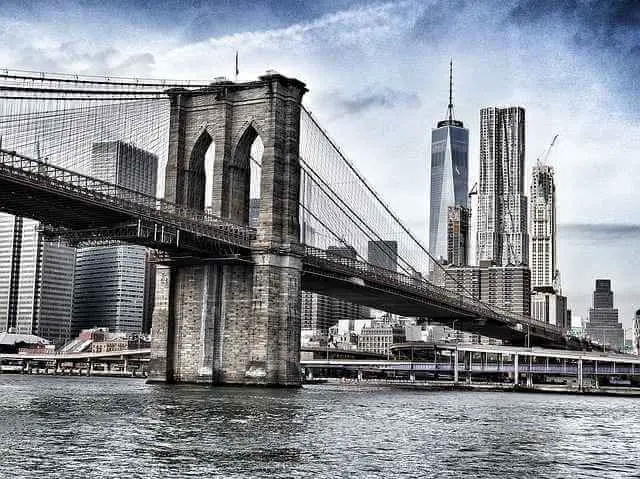
Brooklyn Bridge Walk – Self Guided Walking Tour
- Search Please fill out this field.
- Newsletters
- United States
- San Francisco
- Neighborhoods
San Francisco Chinatown Self-Guided Walking Tour
:max_bytes(150000):strip_icc():format(webp)/betsy-hikey-1000x1500-56a386bf3df78cf7727ddc41.jpg)
Melissa Zink / TripSavvy
San Francisco's Chinatown has more guided tour options than the local herbalist has ginseng roots. Many of them are informative and entertaining, but they control the schedule, and you have to plan around that. If you'd rather:
- Tour Chinatown when you want to
- Stay as long as you want at places of interest
- Skip the bits that bore you
- And do it all for free
This self-guided tour covers all the same sights to which tour guides will take you.
Print this page to take along and you're all set—and you can't beat the cost savings.
This walking tour takes you off the main streets into alleys and areas where you'll find some unique Chinatown sights. At a leisurely pace, it takes about 2 hours, including a stop for lunch. If you're a shopper, it may take a bit longer than that.
The total walking distance is 1.5 miles, and it's nearly flat.
Get Ready to Tour Chinatown
Chinatown is woefully short on public restrooms. Your best bet is to find one before you go in. There's a Starbucks at the corner of Sutter and Grant, just a block from the Chinatown gate.
Chinatown Gate to Portsmouth Square
Today's Chinatown was rebuilt after San Francisco's 1906 earthquake, and its architecture is an odd mix of Edwardian fundamentals and Chinese details. Starting from the Chinatown Gate on Bush Street, on Grant Avenue:
- Start at the Chinatown Gate: This 1970 addition to the Chinatown entrance marks the transition into Chinatown from Union Square. A pair of Chinese guardian lions is traditionally believed to provide protection. Called Shi in Chinese or "Foo Dogs" in the West, they're a common sight in front of Chinese Imperial palaces, Imperial tombs, government office, and temples.
- Walking on Grant Avenue: Grant is especially touristy near the Chinatown gate. It's a good place for souvenir shopping, with several large shops offering t-shirts and other trinkets. Further up the street, you'll also find modern Asian items that are both stylish and easy on the pocketbook. This part of Grant is a good place to stop and look up. This isn't a ploy to make you look silly: a couple of interesting things are above eye level. Look around and you'll see that the street signs are written in both English and Chinese and the ornate streetlights (put up in 1925) are supported by golden dragons.
- Stop at St. Mary's Church: Grant at California. The granite stones used in this historic church's foundations came from China and its bricks came "around the Horn" of South America with the gold seekers. It was the first church built as a cathedral in California and for many years was one of San Francisco's most prominent buildings. Inside is a small display of photographs from the 1906 earthquake and fire, showing both how badly it was damaged and how closely the new structure resembles its predecessor.
- Walking: When you cross the cable car tracks at California Avenue, listen. Not only will it help you avoid an approaching car, you'll also hear the cables that move the cars humming beneath the street.
- Stop at the Wok Shop : 718 Grant Avenue. This long-time Chinatown shop sells an extensive selection of cleavers, woks, and chopsticks, all of which make great (and useful) souvenirs.
- Stop at Eastern Bakery : 720 Grant Avenue. Opened in 1924, Eastern is the United States' oldest Chinese bakery. Mooncakes are their specialty, filled with a light melon or rich-tasting lotus-seed paste.
- Walking: At Clay Street, turn right, then go left to enter one of San Francisco's original city parks.
- Stop at Portsmouth Square : One of three city parks set aside by San Francisco's first mayor, Portsmouth is Chinatown's social center, with residents using it as an extension of their homes, taking the kids there to play or meeting friends. You'll sometimes find men playing Chinese chess (also called elephant chess) and groups of women playing cards. Also in the park is the Robert Louis Stevenson Memorial and a marker commemorating the first public school in California. The only public restroom on the tour route is in the park, but be warned—cleanliness can be an issue.
- Walking: Cross the park to Washington Street and turn left.
Portsmouth Square to Broadway
- Stop at the Old Telephone Exchange: (743 Washington) This lovely building is now the East West Bank, but it started out as the Chinese Telephone Exchange. Callers often asked for people by name only, thinking it rude to refer to a person by using a number, so the operators working here had to know each subscriber by name. With many subscribers having the same name, they also had to know everyone's address and occupation. And - they had to speak not only English but also five Chinese dialects. Today's building was rebuilt after the 1906 earthquake and fire.
- Walking: At Grant Avenue, turn right—or take a shortcut through Wentworth Place to Washington Street.
- Chinatown Restaurant Row: Between Grant and Kearny Street on Washington are some of the best-rated restaurants in Chinatown.
- Walking: After looking around or having a bite to eat, return to Grant Avenue. This route bypasses one of Chinatown's best-rated tea shops, Red Blossom. If you want to stop in, turn left on Grant to get there. Otherwise, turn right at Grant and continue.
- To Buy a Unique Souvenir: Talk to the folks outside the door at 924 Grant or enter through the nondescript lobby and you'll find a place to get one of Chinatown's most unusual souvenirs, a custom-made, carved stone stamp from Rainbow Sign and Art.
- Be Prepared for Game Birds: In the block between Pacific and Broadway on the right side of the street is a small shop called Ming Kee Game Birds. They sell birds used in Chinese cuisine, including a blue-skinned chicken. FYI: Several years ago, a lot of controversy arose over Chinatown shops selling live poultry and shop owners are still sensitive to gawkers and photographers.
- Stop at the Chinatown Mural: At the corner of Columbus Avenue and Broadway where Chinatown meets North Beach, you'll find a mural on the corner building. One side commemorates North Beach's Italian roots. The side facing Broadway is dedicated to San Francisco's Chinese heritage
- Walking: At Broadway, turn left. At Stockton, cross the street and turn left again, walking along Stockton.
Stockton Markets and Alleyways
- Explore the Chinese Markets: The next two blocks of Stockton are packed with markets. Some sell the same kinds of vegetables and groceries you'd find at a neighborhood store anywhere, but others sell fresh fish, Asian specialty vegetables, and foods. For fun people-watching, look for older Chinese women shopping, arguing over asparagus, wrangling over radishes or shaking an eggplant to see if it's firm.
- Walking: At Jackson Street, turn left, then turn right into Ross Alley (which is halfway to Grant)
- Stop at the Golden Gate Fortune Cookie Factory : (56 Ross Alley) It's not what you might expect of a factory, but more like a Wallace and Gromit invention gone awry. Some people think the staff rude, and they'll give about 30 seconds to look around before insisting you buy something, but it's worth a look and something you're not likely to see anywhere else. Bring cash if you want to buy some fresh fortune cookies and expect to pay to take a photo, too.
- Stop at the Sam Bo Trading Company: (50 Ross Alley) This small shop sells Buddhist and Taoist religious items, Buddha statues, incense and paper goods burned in tribute to ancestors and the gods. A pack of handmade paper printed in gold purchased here makes an inexpensive, beautiful souvenir.
- Walking: At the end of Ross Alley, go right on Jackson and then left into Spofford.
- Explore Spofford Alley: There's not a lot to see in this short alley, but listen: it's home to numerous mahjong parlors and you can hear the tiles clicking as you pass, especially on weekends when you might also get a glimpse inside through an open door.
- Walking: At the end of Spofford, turn left and walk to Waverly Place. Turn around at Washington to walk the street's two-block length.
- Explore Waverly Place is often called the Street of the Painted Balconies, but it wasn't built for tourists and these days the paint is growing a bit faded. Walk along its two-block length and you'll find a dry cleaner, travel agency, employment agency two funeral businesses and two temples. Amy Tan fans may recall the name Waverly from "Joy Luck Club," and Dashiell Hammett's "Dead Yellow Women" is also set here.
- Stop at the Tien Hou Temple : (125 Waverly Place) The smell of temple incense is one of Chinatown's sensory treats, and you'll find plenty of it on the top floor at 125 Waverly Place, in a temple dedicated to the Goddess of Heaven. After you climb the long stairway, you'll find a tiny, incense-filled room hung with red and gold lanterns, several shrines and a statue of the goddess in the back. They don't mind respectful visitors (but don't allow photographs). Admission is free, but I recommend making a small donation, just to be polite.
- Family Benevolent Associations: You'll see the offices for several of these associations on Waverly Place, including the Eng and Wong families. They began as social clubs to serve social and personal needs of Chinese workers and provide political and social support systems to newcomers. These days, they are mostly gathering places, particularly for older Chinese who live in Chinatown.
- Bing-Tong Kong Freemasons: During the early twentieth century, Bing-Tong Kong was one of San Francisco's most powerful Tongs, groups often compared to modern gangs. In the 1930s, it started using the name "Chinese Free Masons," but whether they are formally associated with that organization is unclear. This building appears briefly in the 1982 film Chan Is Missing , directed by Wayne Wang.
- Stop at the Clarion Music Center (816 Sacramento Street) sells Chinese drums, cymbals, flutes, Tibetan singing bowls and many unusual instruments and is well worth a stop if you like that kind of thing. They are closed on Sundays.
The easiest way to get to many other parts of San Francisco from Chinatown is by cable car. Find everything you need to know about riding them in the San Francisco Cable Car Guide .
- If You're Done for the Day: Turn left at Sacramento Street and right onto Grant. Walk 3 blocks and you'll be back where you started.
- To Go to Union Square : Turn right on Bush, left on Stockton and you'll be there in 3 blocks
- To See the Ferry Building, Waterfront, Bay Bridge : Turn left on Grant to California and catch the cable car (the one going downhill)
- To Check Out Nob Hill: Turn left on Grant to California and get on the cable car (the one going uphill)
- To Go to Fisherman's Wharf : Turn right on Sacramento and walk 2 blocks to catch the Powell-Mason or Powell-Hyde cable car
- To Explore North Beach: Turn right at Sacramento Street and then right onto Stockton. It's about 6 blocks to the edge of North Beach from there
Apps for Your Chinatown Tour
Sutro Media's San Francisco Chinatown app provides a map and an A to Z listing of points of interest. The map is filled with detailed icons, but unfortunately, they overlap and are hard to read on a mobile phone screen. If you're the type who likes to wander but occasionally wants to know more about something, you may find it useful.
The free app City Walks provides minimal information and you'll have to pay for an upgrade to access their guided tours. It's a pricing strategy, this app rates only 2.5 stars out of 5, largely because of complaints that the free version has nothing to offer.
Time Shutter - San Francisco is custom-made for history buffs and anyone who wonders what a place looked like long ago. Using their map- or list-based index, you can bring up historic photos of the place you're standing. Double-tap and they'll transform into modern-day views.
Related Articles
More related articles.
Get 20% Off on Market 57 or Tasty Global Bites Tour by Purchasing Chinatown & Little Italy Food Fest
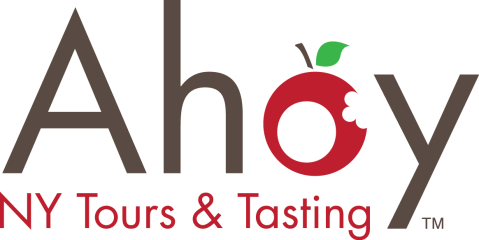
- Original Chinatown and Little Italy Food Tour since 2009
Chinatown and Little Italy Food Fest Walking Food Tour
A NYC Walking Food Tour for All Ages
Quick Details
- Hour Glass Duration: 3 hours
- Users Ages: All ages
- Map Marker Tours end: in a convenient location, walking distance to the meetup location and nearby subway stations. Your guide will help you navigate to your next destination.
- Checkmark Food Restrictions: With advanced notice, we can fulfill most requests (vegetarians, gluten- free, no shellfish, etc.). See options at check-out.
- Info Important Information: Tours are conducted with a maximum of 12-13 guests only. There are 2-3 seated tastings and 5-6 on-the-go tastings to ensure that you explore both neighborhoods in 3 hours. Tastings are subject to change. Customers may cancel up to 72 hours before the tour and receive a full refund or credit. Any cancellations after 72 hours prior to the tour customers will be given a gift card that does not expire in the amount initially charged.
Enjoy the Best Food Tour in Little Italy & Chinatown, established 2009!
Enjoy our signature 3 hour food tour of 2 historic nyc neighborhoods this tour has 2-3 seated tastings and 5-6 on-the-go tastings to ensure that you explore both neighborhoods in 3 hours..

Experience Chinatown and Little Italy through flavor, culture, and history. As your intimate group is led through the maze of the streets that make up Chinatown and Little Italy, your licensed guide will make sure to entertain you with fascinating historical stories and fill your stomach with delicious tastings. You will be sure to discover secrets of the city, historic parks, and exquisite NYC architecture. After the tour, your guide will provide plenty of tips on additional places to see and eat. This added service makes it easy to continue your Ahoy New York Food Tours adventure long after it concludes.
Enjoy 8 tastings during this fun tour for both locals & visitors alike:
- Eight different food tasting locations that fuse the elements of history, culture, and food.
- There are 2-3 seated tastings and 5-6 on-the-go tastings to ensure that you explore both neighborhoods in 3 hours.
- All food tastings are included, enough for lunch.
- For guests 21 and up an option to add a glass of wine or beer at the seated tasting is included!
- Each guest is provided a handout that includes a map, neighborhood recommendations & discounts.
- Visit family-owned shops, off-the-beaten-path NYC locations , and establishments that have been in business for over 100 years.
- Tours conducted in small intimate groups led by a friendly licensed guide to ensure a personable experience.
- This tour is significantly different from our Tasty Global Bites tour.
Food Tour Highlights:
- Satisfaction Guaranteed
- Certificate of excellence on Trip Advisor for 14 years
- Photography Encouraged
- Multiple tours weekly, starting at 10:30 AM. Different tour times may be added
- Rain or shine
- All food tastings enough for lunch included in ticket price
- With advanced notice, we can fulfill most requests (vegetarians, gluten-free, no shellfish, etc.)
Our Delicious Tastings (family run businesses, some 100 years & older)
- A popular Chinese pastry paired with jasmine green tea (seated)
- A Chinese sponge cake with a twist
- Authentic Chinese dumplings
- Scrumptious Roasted Duck or OG egg rolls
- Seated and hearty tasting of Italian cuisine with choice of wine or beer
- Delicious imported Italian cheeses and olives
- Fresh pasta with an outstanding marinara sauce
- A well-known Sicilian pastry, cannoli

- Chevron down What type of food will we taste on the tour?
Food tasting locations can change without notice.
- Chevron down Can I bring my children on the tour?
While we welcome children on our tours, our tours are mainly for a mature audience in that we taste a variety of cuisine and dive deeply into history and culture. Sometimes we find that children of a young age may become easily disengaged. Although we are a family-friendly tour company, please take care in knowing if your child will enjoy the experience prior to booking. We find that children 8 years old and older enjoy our Little Italy & Chinatown Food Tour.
- Chevron down How much walking is involved?
We walk no more than ½ a mile at a moderate pace. During the three hours, there are many standing breaks, so we aren’t always walking. There are a few opportunities to sit throughout the tour.
- Chevron down Is the tour wheelchair and baby stroller accessible?
Although we would like to try to cater to your wheelchair and stroller needs, it takes time for us to coordinate due to the geographic limitations of the area. With notice, sometimes we can accommodate your needs.
- Chevron down Will there be restroom stops on the tour?
Yes, on our Little Italy & Chinatown Food Tour, there is a restroom at our first tasting location and at our sit-down tasting (about half way through the tour).
- Chevron down Do you accommodate dietary restrictions and allergies?
Ahoy New York Tours & Tasting does its best to accommodate any dietary restrictions and allergies. Please alert us upon booking your tour/dining experience.

My boyfriend and I decided to take a food tour of Chinatown and Little Italy to try some new foods and learn about the culture/ history of these neighborhoods and Hannah did not disappoint! As a picky eater, this was a great way to open up a bit more while learning + sightseeing the area. Hannah provided great insight into how these neighborhood + cuisine developed, answered tour and non-tour related questions, and made this a great experience for us. You could tell Hannah truly enjoys sharing this experience and I would recommend this to tourist and locals alike!
We took 4 food tours while on our trip and this one is by far the best! Patrick was FANTASTIC and got us trying foods that we never would have stumbled upon on our own. We sampled tons of wonderful food and learned so much history about the city. We left full and will definitely do it again next visit!
A wonderful experience with great food, lots of history, and fun! Shout out to our guide Lily who absolutely made the experience. She was knowledgeable and added lots of fun to the tour!! 11/10 Would recommend and even more so if Lily is the guide!!

Related Tours
- Sells Out Quickly
- Hour Glass 3 hours
- Users All ages
Tasty Global Bites – A Culinary Journey through Nolita (North of Little Italy)
Travel without a passport on this great walking food tour! Discover Nolita (north of Little Italy), taste foods from five different cultures, and learn about the area’s storied past!
- Indoor tour with stunning views of NYC
- Hour Glass 2 hours
Market 57 Chelsea Food Tour
Explore New York City’s diverse flavors, all in one place. A 2-hour indoor food tour of the diverse Market 57, featuring seven tastings each skillfully prepared, not to mention amazing views of the Statue of Liberty and Little Island.

- Destinations
- Private Tours
- Historical Tours
- South Korea
- United Arab Emirates
- Czech Republic
- Brussels NEW
- Belfast NEW
- Copenhagen NEW
- Palermo NEW
- Netherlands
- Stockholm NEW
- San Sebastián NEW
- Valencia NEW
- United Kingdom
- United States of America
- Cincinnati NEW
- Houston NEW
- Los Angeles
- Philadelphia
- Portland, Oregon
- San Francisco
- Seattle NEW
- Washington D.C.
- Mexico City
- Rio De Janerio
- Buenos Aires NEW
- Mission District
- North Beach & Chinatown
- Learn to Roll Sushi Like a Pro
- Mastering Fettuccine Alfredo
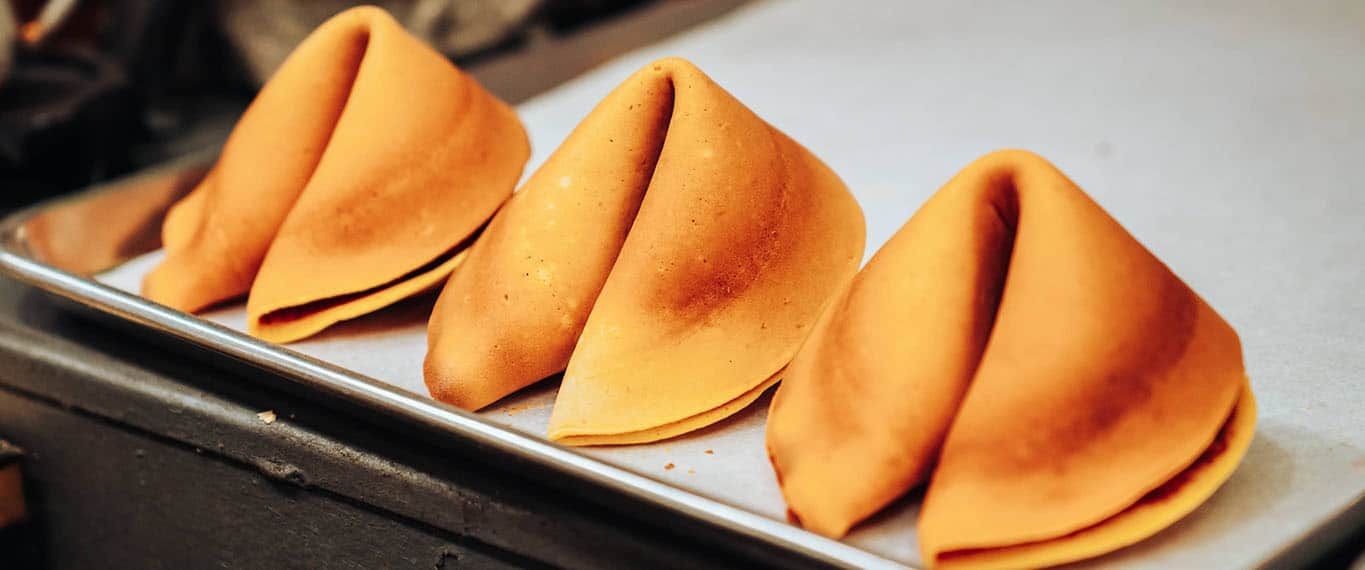
San Francisco- Secret Food Tours

San Francisco is a vibrant city that entices individuals worldwide to visit because of its appealing beauty, rich history, diverse cultures, patchwork communities, and world-class cuisine.
The Mission District, North Beach, and Chinatown are three of the most culturally rich neighborhoods in San Francisco. North Beach is known for its Italian heritage and is home to some of the best Italian restaurants in the city. Chinatown is one of the largest Chinese communities outside of Asia and is home to many shops, restaurants, and markets that offer a glimpse into Chinese culture. The Mission District is known for its vibrant street art scene and is home to many galleries and murals. There are many things to do in these neighborhoods; let’s discover them together!
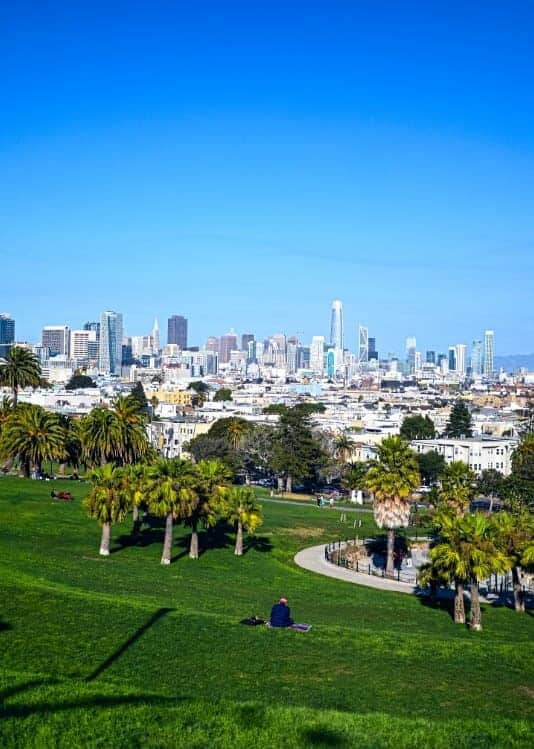
On our Secret Food Tour: San Francisco - North Beach and Chinatown, you’ll experience the most iconic parts of “The City by the Bay.”
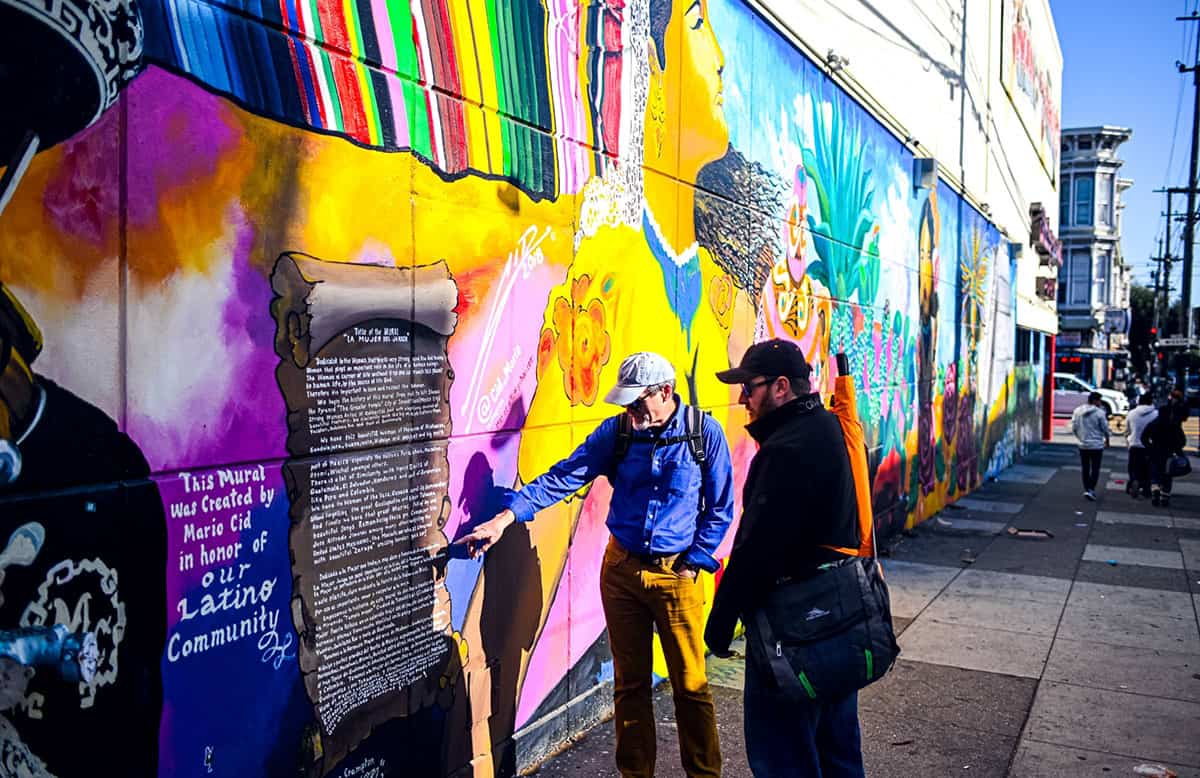
On our Secret Food Tour: San Francisco - Mission District, you'll see how immigrants shaped the neighborhood by sharing their fantastic food!
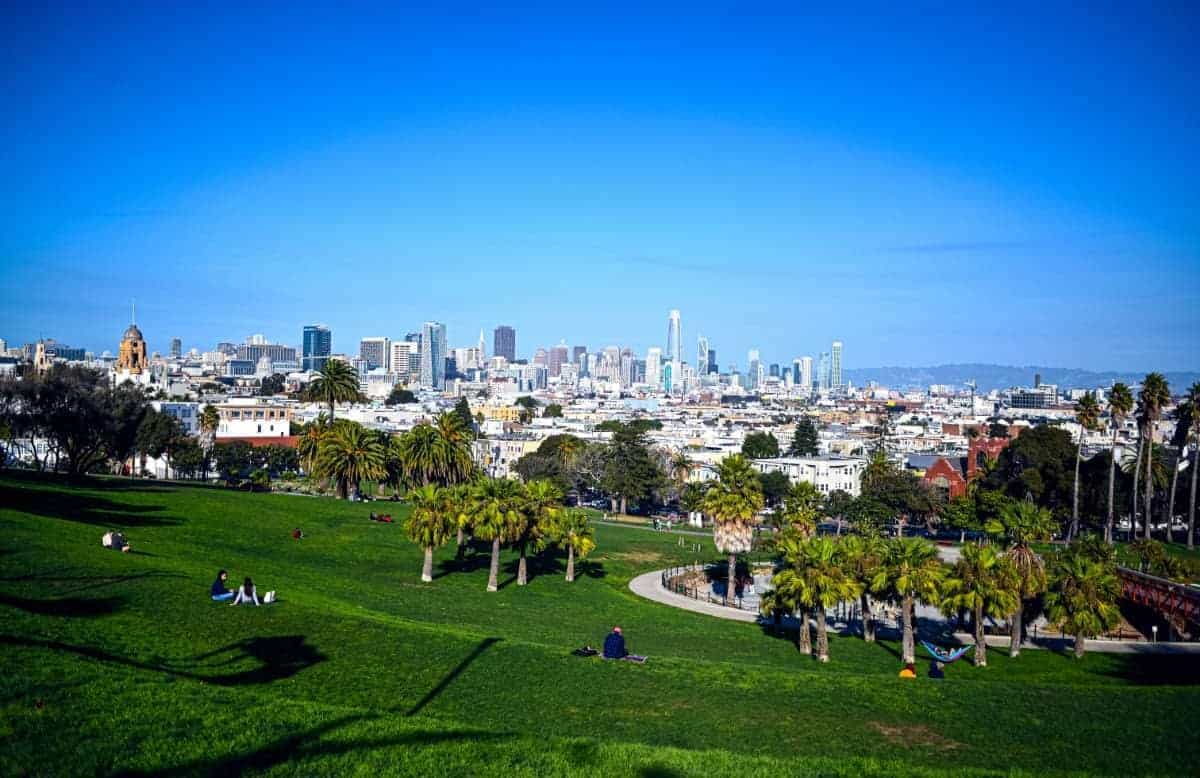
Learn the story of the immigrants that shaped the San Francisco food scene and how San Francisco shaped them. Many foods that are commonly thought of as Mexican and Chinese were actually invented in San Francisco.
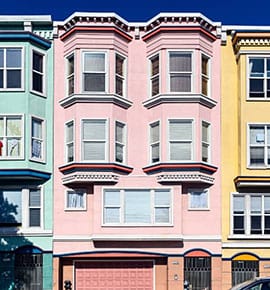
- Book Your Tour
- Our San Francisco Tours:
- Cooking Classes
- Photos/Video
- Destinations
- Group & Private Tours
- Read About Us
- San Sebastián
- New York City
- Rio de Janerio

This website uses cookies to improve your browsing experience and analyze the use of the website. Learn More

Self Guided Tour of Chinatown San Francisco

When stepping into San Francisco’s Chinatown, you step into a world of vibrant colors, sounds, sights, and smells that will immediately whisk you around the globe.
While there are several distinct Chinese neighborhoods in San Francisco, the oldest and largest Chinatown lies in the heart of downtown. On this self-guided tour of Chinatown, you’ll visit sights with a history dating back to the days of the early explorers, see unique and beautiful views of the city, and be immersed in a culture so intertwined in San Francisco’s history that you just can’t miss it!
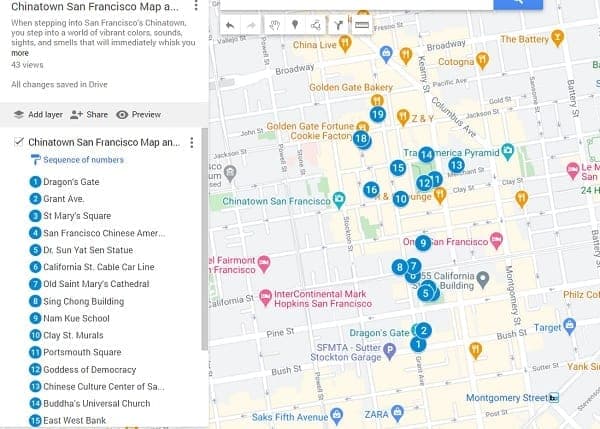
Click the map to enlarge or to download to a smartphone.
You can also download San Francisco Chinatown Self Guided Tour as a pdf.
Why not join one of our guided tours of Chinatown ?
Also, if you are considering purchasing a hop-on, hop-off Big Bus ticket , their buses makes stops in Chinatown and your ticket will include a free Chinatown walking tour.
For more money-saving ideas for your time in San Francisco, check out which tourist discount pass is best .
Or, check out a video of a walkthrough Chinatown, and see many of the sights that you'll be visiting on your own trip!
BRIEF HISTORY OF CHINATOWN
One of the largest concentrated Chinese populations outside of China, San Francisco’s Chinatown is the oldest in North America and the largest outside of mainland China.
The earliest Chinese immigrants to the Bay Area came in the 1840s, just before the Gold Rush.
Some of those early Chinese immigrants began referring to San Francisco as “Gold Mountain,”.
And just as fortune seekers hurried west across the country to hunt gold, so too did Chinese immigrants come into the Bay seeking new lives.
As one of the most accessible mainland North American ports, San Francisco’s Chinese population grew steadily to become what it is today.
Now, as you walk through the hustle and bustle of Chinatown, you’ll feel as if you’d stepped off a plane and landed in Hong Kong.
If it weren’t for the towering Transamerica Building to the east or views of Coit Tower farther north, you might forget that you’re in San Francisco at all.
While taking this tour, be sure to take some time to look in the many different shops along the way. We’d run out of space if we tried to list them all, but you can find practically anything in Chinatown.
We begin this walking tour at the iconic Chinatown Dragon Gate, the entry to Chinatown, and complete it farther north along Grant Ave., where Chinatown and North Beach intersect.
Heads up: This being San Francisco, you will have a few hills to climb. Don’t be too concerned, most uphill sections are fairly short or broken up with stops.
Begin the tour at the Dragon Gate, located at the intersection of Grant Ave. and Bush St.
Stop 1 - Dragon Gate
One of the most photographed sights in San Francisco, the Dragon Gate officially marks your entrance into Chinatown.
Though the Chinese community began creating Chinatown as we know it in the aftermath of the 1906 earthquake, the official entrance to the neighborhood wasn’t marked until 1970.
Chinatown representatives eagerly pushed for a ceremonial archway, a common entrance to most Chinese villages, in order to show how similar San Francisco’s Chinatown was to a traditional Chinese village.
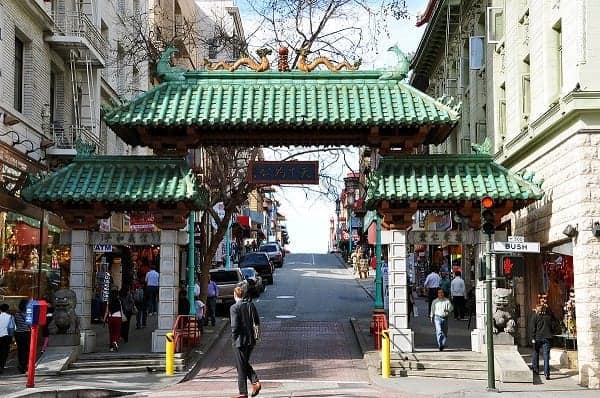
Designed by Clayton Lee, a Chinese American architect, the Dragon Gate is one of the most spectacular and authentic in any American Chinatown.
Built mainly in Taiwan and covered in beautiful Taiwanese tiles, the Dragon Gate stands as a beacon welcoming visitors under its archways.
Be wary of which archway you pass under, though! The two side passageways are for the common people, while the larger center passage is reserved for esteemed dignitaries and important citizens… and delivery trucks.
As you walk past the Dragon Gate, check out the dragons standing guard on each side - it’s said that they’re busy keeping evil spirits out.
Stop 2 - Grant Avenue
Formerly called Dupont St., Grant Avenue was once the center of San Francisco’s red-light district.
Following the vast destruction of the 1906 earthquake, Chinatown took a firm hold of the area and never looked back.
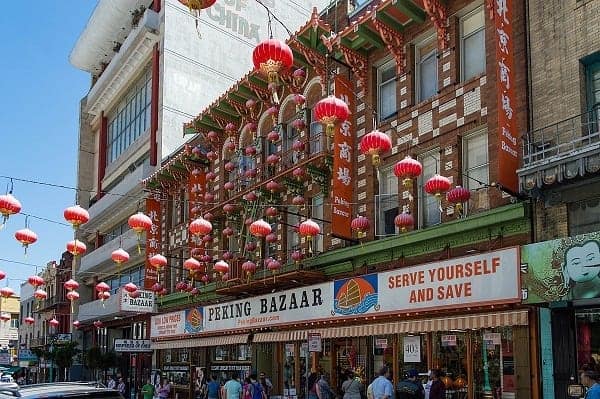
To boost tourism in the neighborhood, representatives began encouraging the use of traditional Chinese designs and architecture, much of which you will see as you walk along Chinatown’s “Main Street,” Grant Ave.
Stop 3 - St. Mary’s Square
This may be one of the calmest locations in Chinatown, so relish it while you can.
Occasionally occupied by tai chi groups, St. Mary’s Square is prime real estate that’s very existence is continually in question.
Located on the fringes of both Chinatown and the Financial District, it is not as busy as Portsmouth Square (a later stop).
Various businesses have attempted to purchase the land for office buildings, but recent rebuffs from Chinese cultural groups almost ensure that it will remain open green space.
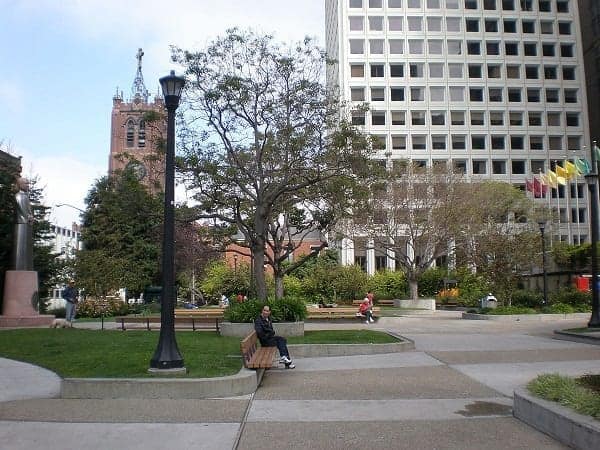
Though the area is fairly calm now, during San Francisco’s rough and tumble Gold Rush days, the square housed some of San Francisco’s most notorious houses of prostitution.
The area changed drastically in 1906 when the houses were destroyed in the fires caused by the great earthquake.
Following their destruction, city officials decided to put a park in their place. The park is named for Old St. Mary’s Cathedral, located across California St.
Stop 4 - San Francisco Chinese American War Memorial
In St. Mary’s Square, you will see two important memorials.
First, on the metal fence near the center of the square is the San Francisco Chinese American War Memorial plaque dedicated to those Chinese Americans who served and gave their lives for the United States during World Wars I and II.
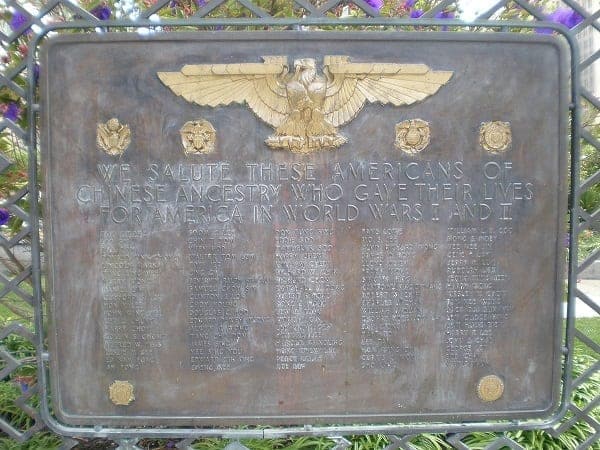
The plaque lists the names of those killed and shows the emblems of the different branches of the military represented by Chinese Americans.
The American Legion and Veterans of Foreign Wars seals are at the bottom of the plaque.
Stop 5 - Statue of Sun Yat-sen
The other memorial in St. Mary’s Square is a Benny Bufano statue of Sun Yat-sen, erected in 1937.
Sun, an exiled anti-imperialist known to many as the “Father of Modern China,” worked fervently through the early 1900s to overthrow the Qing dynasty, only to see his efforts rewarded with exile from his home country.
He came to San Francisco and, it is said, often relaxed in St. Mary’s Square.
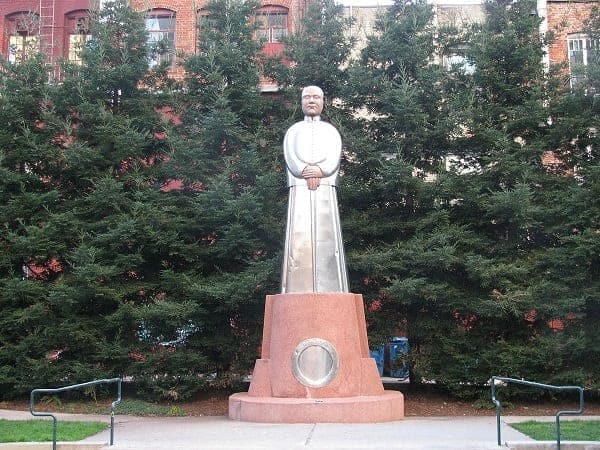
Unfortunately, his life in San Francisco was not completely restful; agents of the Qing dynasty were constantly searching for him, and he was often in hiding.
Sun Yat-sen’s famous words, “The world is for all, all is for the people,” are inscribed in traditional Chinese characters on the Chinatown Dragon Gate.
Benny Bufano, the sculptor of Sun’s statue, was born in Italy but lived in San Francisco for much of his life. His works can be seen throughout the city.
Stop 6 - California St. Cable Car Line
The cable car is one of San Francisco’s most iconic sights, and the California St. line is the oldest cable car line in the country.
The San Francisco cable car, invented by Andrew Hallidie in 1873, became one of San Francisco’s most important modes of transportation for the next forty years.
Now, the California St. line is only one of three remaining cable car lines in San Francisco.

This particular line was put in by none other than Leland Stanford (sound familiar?).
Stanford, whose mansion was just up the street on Nob Hill, made a vast fortune putting in railway lines around the country.
He remains one of the Bay Area’s most controversial figures, as the Chinese laborers who laid the rails for his business were vastly underpaid and extremely overworked.
If you are interested in learning more about the history of the San Francisco cable car, visit the Cable Car Museum on the corner of Mason St. and Washington St.
You can also access all riding information on the San Francisco Cable Car website here: https://freetoursbyfoot.com/cable-cars-san-francisco/
Stop 7 - Old St. Mary’s Cathedral
One of the longest standing structures in San Francisco (1853), Old St. Mary’s Cathedral was once the tallest building in the city.
St. Mary’s was originally built to be the seat of the Catholic Church in San Francisco.
Commissioned by San Francisco Bishop Joseph Alemany of Spain and designed by architects William Craine and Thomas England, the cathedral was designed to replicate a gothic church in Alemany’s hometown of Vich, Spain.
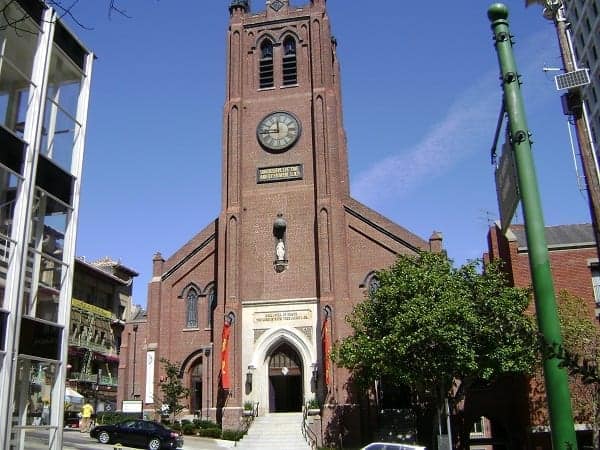
The cathedral was dedicated during Christmas Midnight Mass in 1854 and continually grew from that point on.
By 1881, however, it was decided that the cathedral would no longer remain in the declining neighborhood.
The structure remained and was eventually put under the charge of a Paulist order of priests (and the new St. Mary’s Cathedral was later built on Geary St.).
The Paulists had long run a Chinese Mission and brought this to St. Mary’s, thus making it an integral part of Chinatown. This same order of priests continues to run the church today.
The church went on to withstand both the 1906 and 1989 earthquakes, and three of the walls are original. You are welcome to go quietly inside the church, even while Mass is going on, as there is a designated historical section in the back of the church.
Before you go inside, take a look below the central clock. The words read, “Son, Observe the Time and Fly from Evil. Ecc. 4:23.”
Some believe those words were put there to turn men away from the brothels located directly across the street.
Stop 8 - Sing Chong Building
The oldest piece of Chinese architecture in San Francisco (1807), this building was actually designed by a Scottish architect.
Thomas Patterson Ross, an Edinburgh native, was a major architect in San Francisco following the 1906 earthquake and most well known for the Alcazar Theater he designed on Geary St.
His design for Sing Chong, as well as the neighboring Sing Fat building across the street, represented a shift in post-earthquake San Francisco.
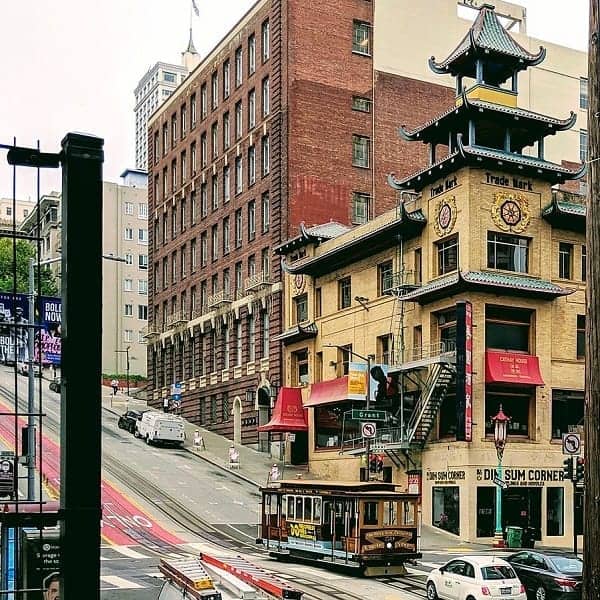
Chinese immigrants and Chinese Americans pushed to create a “city within a city.”
Sing Chong proprietor (and First Bank of Canton founder) Look Tin Eli recommended the pagoda style architecture to entice tourists into Chinatown.
Stop 9 - Nam Kue School
A small Chinese-style building gated and drawn back from the street, Nam Kue School first opened its doors in March 1920, though the idea for it came about a year prior.
At the time, a group of prominent Chinese-Americans in San Francisco decided something must be done to preserve Chinese culture with future generations, so this and several other schools opened for American-born Chinese children.
Taught history, culture, and language, the Nam Kue School continues to welcome children through its doors.
Up until 2005, the school flew the flag of the Kuomintang, also known as the Chinese National Party.
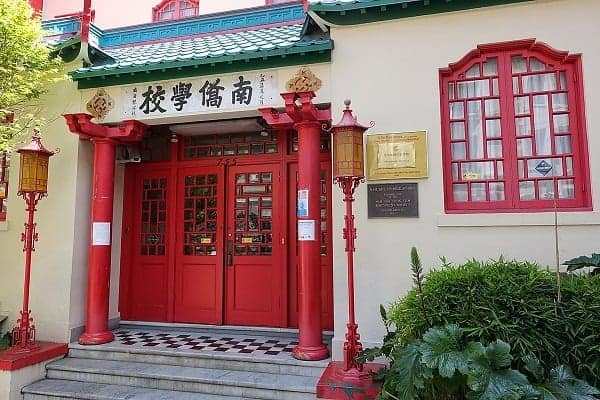
The Kuomintang, started by Sun Yat-sen, opposed both the Qing dynasty and the emerging presence of communism in China.
In 2005, because of better relations between the United States and the People’s Republic of China, the Kuomintang was replaced with a People’s Republic flag.
Just next to Nam Kue School is Kee Photo. Take a look at all the photos on their front window. The owner, Mr. Kee, has photographs of himself with celebrities and entrepreneurs on display.
Look closely and you’ll see former Governor Arnold Schwarzenegger, Microsoft’s Bill Gates, and many more.
If you happen to need passport photos, apparently Mr. Kee is quite cheap and efficient with those.
Head back up to Grant Avenue and make a right turn onto it. Continue walking along Grant until you reach Commercial St. On the Commercial St. side of the Eastern Bakery, there is a wall of murals.
In 2010, British street artist Banksy left his mark with a ‘Peaceful Hearts’ Doctor image on the wall. Though there were efforts to preserve the work, it was eventually sprayed over. The murals on this wall are ever-changing, so take a look and enjoy.
Stop 10 - Clay Street Murals
On the left side of the street (on the side of Asian Image) is a beautiful map/mural/calendar.
Not only does it show the upcoming years and corresponding animals from the Chinese calendar, but also a map of Chinatown.
On the right side of the street is a darker mural, entitled Chinatown 1889.
Painted to capture the difficult history of the Chinese in San Francisco, the first thing you may note is that the figures in the mural are primarily male.
Up until the turn of the century, the majority of Chinese immigrants were young men coming to America for work.
From the early 1880s through the beginning of World War II, Chinese immigrants had to face the realities of the Chinese Exclusion Act.
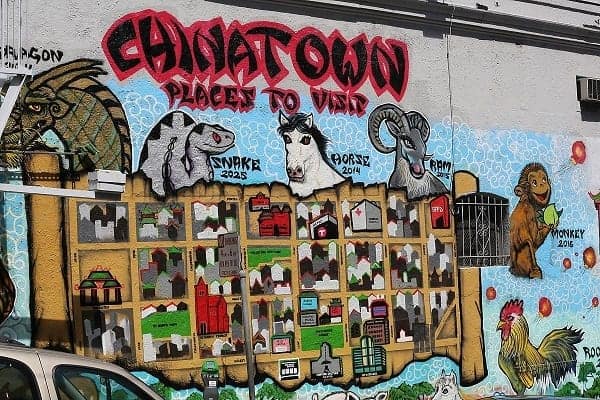
The goal of the act was to keep the number of Chinese immigrants to the city down, though by World War II, with China as an ally, the act was repealed.
In the mural, you may also see a man holding a card with a red L on it.
This referred to the lottery system within Chinatown; it was not a lottery for money, but for work and housing.
Stop 11 - Portsmouth Square
Named for Captain John B. Montgomery’s ship, the USS Portsmouth, this is one of the oldest established areas in San Francisco.
Captain Montgomery (whose namesake street is only a few blocks away) rode into the San Francisco Bay in 1846 to officially seize Yerba Buena (San Francisco’s former name) for the United States.
He then planted an American flag in this public area and soon after, Portsmouth Square became one of the most important in the growing city.
This is where the discovery of gold was first announced in 1848.
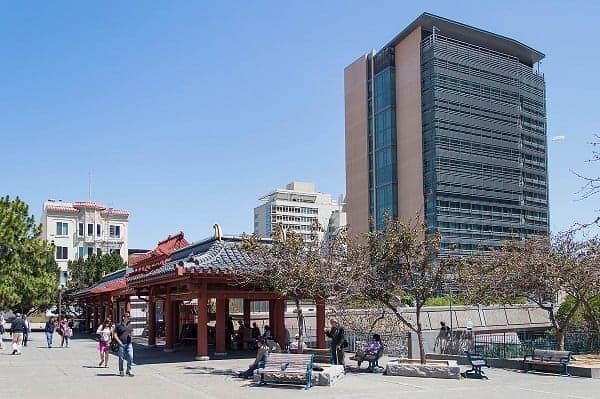
The first city hall and public school sprang up in this square, and it thrived as the center of the city for much of the post-Gold Rush period.
Eventually, as the city shifted its focus toward the Market St. area, City Hall was replaced closer to its present location.
With the shift toward Market St., Chinatown began expanding into Portsmouth Square.
Now, the sight of the first American flag is considered the very heart of Chinatown. Most frequented by a more elderly crowd, you’ll see separate groups of men and women sitting on cardboard boxes and crates playing cards or the traditional game of mahjong.
Bustling with activity, take some time to wander around the square and enjoy.
There remains a plaque commemorating John B. Montgomery’s placement of the American flag, as well as another commemorating the first public school.
There is also a monument dedicated to author Robert Louis Stevenson, who is said to have frequented Portsmouth Square while he was in San Francisco.
Stop 12 - Goddess of Democracy Statue
A 10ft. replica of a 33ft. statue, this lady was one of the lasting images of the 1989 Tiananmen Square protests.
Designed by a group of art students, the original statue was placed in Tiananmen Square in late May 1989.
Placed directly across from a portrait of Communist Party Chairman Mao Zedong, the statue was torn down by Communist officials only five days after it was assembled.
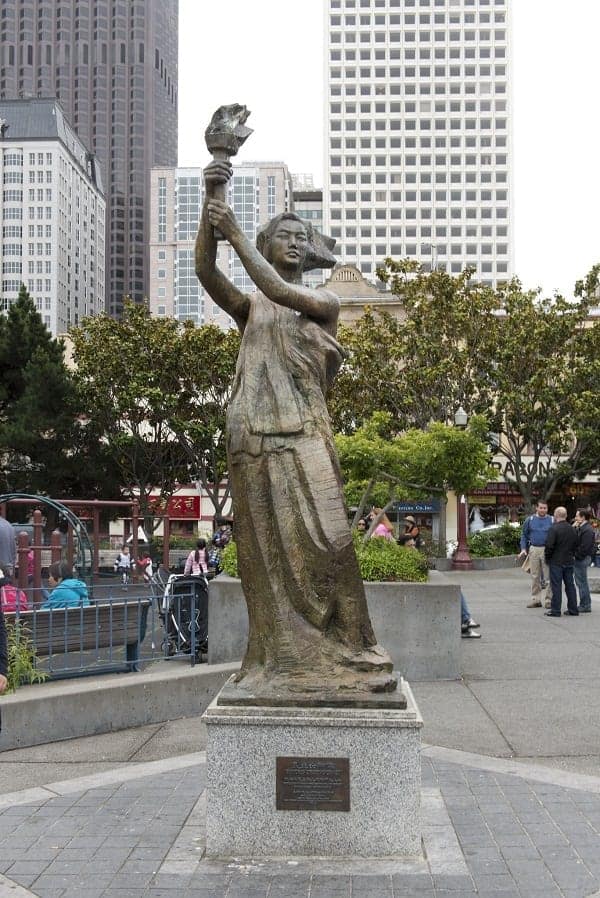
Some say the statue was modeled after the Statue of Liberty. During the 2014 Hong Kong “Umbrella Revolution,” a pink umbrella was attached to the Goddess’s flame in solidarity with protestors.
The umbrella was removed less than a day later. The bronze replica in Portsmouth Square was designed by Thomas Marsh and dedicated in 1994.
Look closely at the statue for names of the various volunteers carved on the back.
For a more in-depth look at the Goddess of Democracy, check out this article from the New York Times Sinosphere blog.
Stop 13 - Chinese Culture Center of San Francisco
You are welcome to enter the Chinese Culture Center to appreciate many different art projects, cultural workshops, and educational information.
The Chinese Culture Center, in existence since 1965, works to bring intercultural understanding to the city and its visitors.
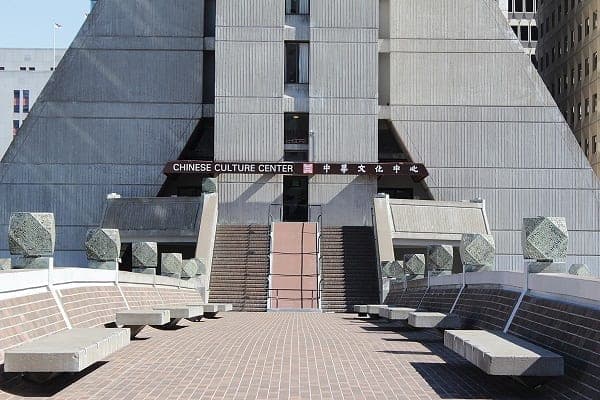
For full information on visiting and present exhibits, visit the CCC website here .
Stop 14 - Buddhas Universal Church
The largest Buddhist church in the United States, this building (a former nightclub and gambling house) has kept its doors open to followers and visitors since the early 1960s when it opened.
Though the exterior is not exactly impressive, take a tour inside to appreciate the beauty and tranquility of this church.
For a complete history, we feel it best to read the church’s own website here .
Stop 15 - East West Bank
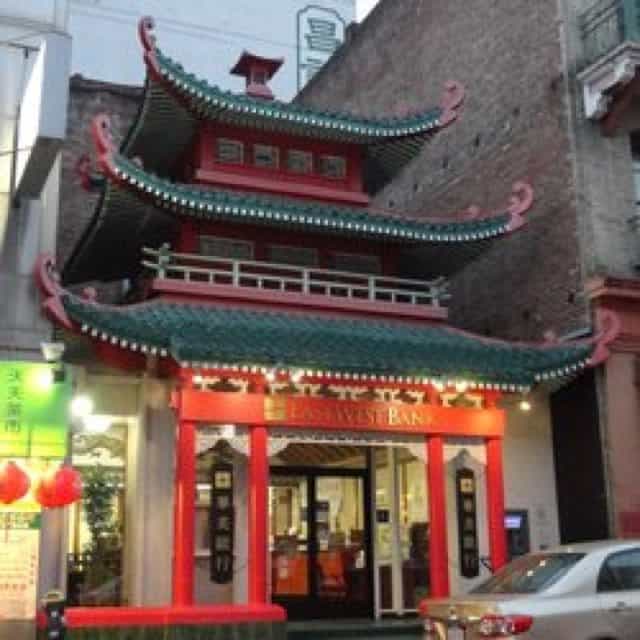
This ornate building was once the home of the Chinese Telephone Exchange.
The Exchange, which began small switchboard operations back in 1891, expanded and grew in this location until the 1906 earthquake destroyed it.
Following the destruction of the earthquake, the Exchange was rebuilt in a decorative Chinese-style building.
It remained there until 1949 when switchboard operations were no longer necessary.
The building was eventually bought by the Bank of Canton in 1960 and has remained its since.
Stop 16 - Tin How Temple
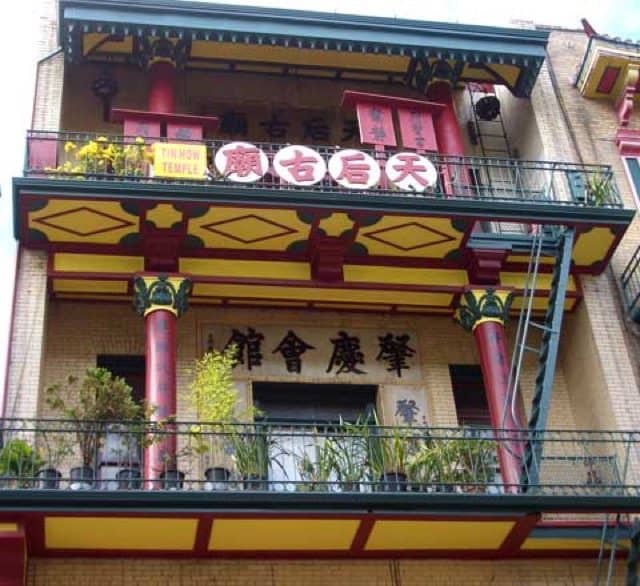
The oldest established Chinese temple community in the United States, the current location of the Tin How Temple postdates the 1906 earthquake.
The original Tin How Temple was opened in 1852 in honor of the goddess Mazu.
The first Chinese immigrants gave thanks to Mazu, Goddess of the Sea, for their safe passage across the Pacific to their new home.
To reach the temple, you’ll have to climb about three flights of stairs to the top floor of the building (there is no elevator access). When you reach the top floor, you’ll enter a vibrant and aromatic vermilion room.
Though you are not allowed to take photographs, you’ll leave with lasting images of the various shrines, red lanterns hanging from the ceiling, and stunning views of the Transamerica Building and Coit Tower from the balcony.
The Tin Temple is open to the public from 9am to 5pm daily. It is still an active temple.
You can leave a donation at the entrance if you are so inclined, and you can also get your fortune read inside.
Stop 17 - Golden Gate Fortune Cookie Factory
The last of its kind, the Golden Gate Fortune Cookie Factory is a Chinatown must. Opened in 1962, it boasts some of the freshest fortune cookies in town.
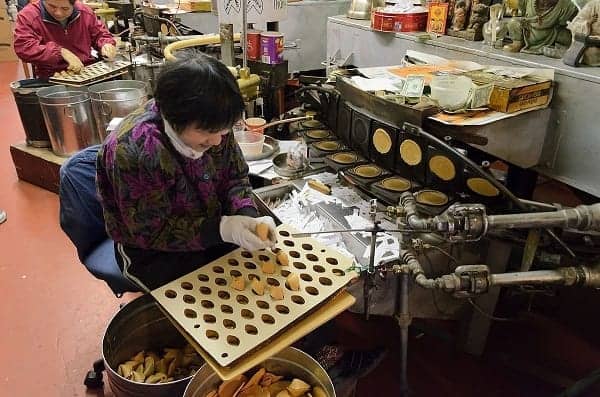
The women who hand-stuff the cookies make almost 20,000 on a daily basis. Take a look inside (for free), snap some pics (for $0.50), and grab a sample cookie on your way out.
The tiny “factory” can get very busy, especially when tour groups shuffle in and out, but it is worth the wait to look inside.
For more information on the history of the Golden Gate Fortune Cookie Factory and the invention of the fortune cookie, visit our blog post here .
Stop 18 - Jun Hu’s Barber Shop
One of Chinatown’s most beloved celebrities runs this little hole-in-the-wall barbershop.
Located just next to the Golden Gate Fortune Cookie Factory, the 80-something-year-old Jun Hu appeared in the opening credits of the Will Smith’s 2006 film “Pursuit of Happyness.”
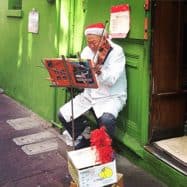
It’s generally agreed that Mr. Hu did cut Paul McCartney’s hair, and his legend fits his charming demeanor.
If you visit from around 9am through noon, you’ll typically find Mr. Hu sitting on a stool outside his shop sporting a white coat and Santa hat; if you’re lucky, he may be playing his erhu (a traditional Chinese instrument).
Jun Hu is also an accomplished violinist.
Stop 19 - Golden Gate Bakery
By and large one of the most popular bakeries in Chinatown, when it’s open, the Golden Gate Bakery typically has a line out the door and down the street.
While there are some tourists who make up that cue, most of those waiting are eager locals.
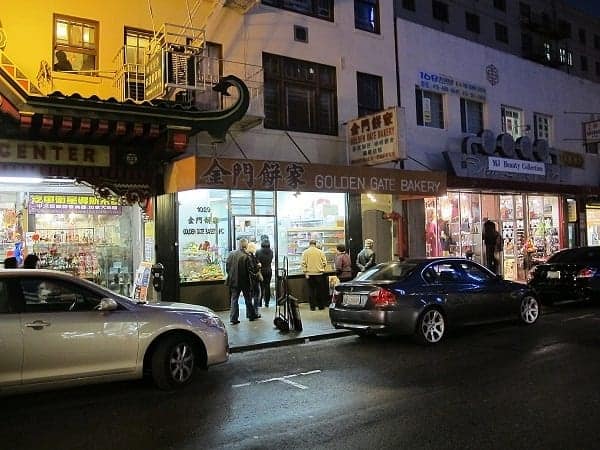
The bakery, famed for its egg custard tarts, keeps its own hours. That means it may be closed when you show up, or it may be open.
Because people are so eager to know when it is open, there is a Facebook page ( Is the Golden Gate Bakery Open Today? ) dedicated to tracking its daily hours of operation.
Continue walking down Grant Ave. to the intersection of Grant/Broadway/Columbus. Ahead of you is the beginning of North Beach. Across the street you’ll see a mural that wraps around the entire building.
The part you are facing depicts scenes from Chinatown, while the opposite side shows the Jazz Era in North Beach.
From here, you can head into North Beach or, if you would like to explore more of Chinatown, we recommend making a left on Broadway.
Walk up to Stockton St. and make a left. On Stockton, you will see the Chinatown beyond the tour books. For the next few blocks, you will walk past fish markets, spice shops, vegetable stands, and more.
The street will be crowded, especially on weekends, as people shop and bargain.
Thank you for joining us on this self-guided tour of Chinatown in San Francisco. We hope you enjoyed it!
Choose a Destination... I want them all PLUS general travel tips. Amsterdam Berlin Boston Charleston Chicago Dubai Lisbon London Los Angeles Miami Nashville New York City New Orleans Paris Philadelphia Prague Rome San Francisco Washington DC
About The Author
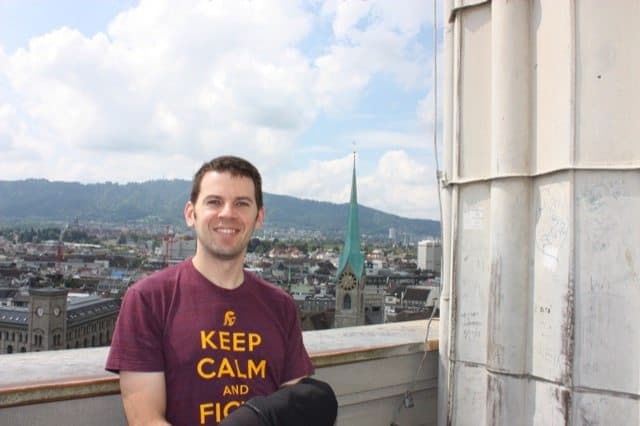
North America
United kingdom & ireland, middle east & india, asia & oceania.

Tuscany: Chianti & San Gimignano Wine Tour From Florence
Tuscany’s Chianti region and the enchanting town of San Gimignano offer a captivating blend of history, scenic beauty, and world-renowned wines. This small-group tour from Florence promises an immersive experience, guiding visitors through the area’s charming landscapes and inviting them to savor the rich flavors that have made this corner of Italy a premier destination. With expert commentary, exclusive wine tastings , and a traditional Tuscan lunch , the tour provides an opportunity to delve deeper into the cultural tapestry that has made Chianti and San Gimignano beloved by travelers from around the globe. What secrets and delights await those who embark on this enveloping journey?

- Small-group Tuscan wine tour from Florence, including visits to two wineries in the Chianti region and a self-guided tour of the historic town of San Gimignano.
- Opportunity to taste Chianti red wine and Vernaccia di San Gimignano white wine, accompanied by a 2-hour lunch featuring regional cuisine in the Chianti Hills.
- Convenient transportation by minivan with hotel pick-up and drop-off, as well as an expert guide to provide insights and enhance the tour experience.
- Suitable for adults aged 99 and younger, with a maximum group size of 8 participants for an intimate and personalized exploration of the Tuscan wine region.
- Highly rated by previous participants, praised for its value, safety, service, and organization, offering an unforgettable experience in the picturesque Tuscan countryside.
More tours and experiences nearby.
- Tuscany Day Trip From Florence: Siena, San Gimignano, Pisa and Lunch at a Winery
- Cinque Terre Day Trip From Florence With Optional Hiking
- The Best Tour in Florence: Renaissance & Medici Tales – Guided by a STORYTELLER
- The Best Tour in Florence: Renaissance and Medici Tales
Tour Overview and Pricing
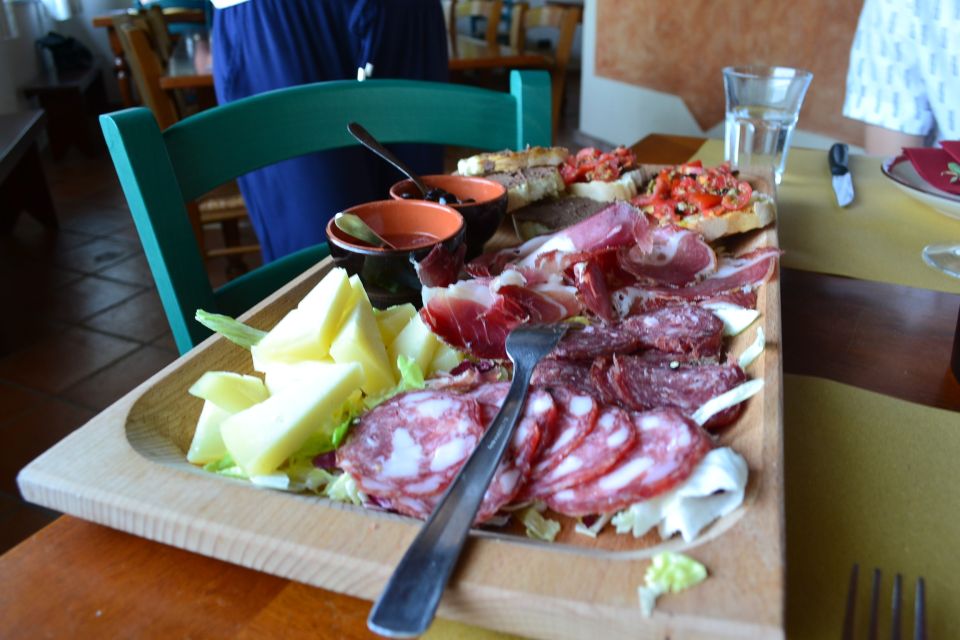
The Tuscany: Chianti & San Gimignano Wine Tour from Florence offers a comprehensive wine tasting experience in the picturesque Tuscan countryside.
Priced from $279.85 per person, this small-group tour lasts 7 hours and is limited to just 8 participants. Travelers can cancel up to 24 hours in advance for a full refund, and they don’t have to pay anything upfront.
The tour includes wine tastings , lunch in the Chianti Hills, transportation by minivan, and a knowledgeable guide.
It’s not suitable for wheelchair users, those with mobility issues, or pregnant women.
Based on 2 reviews, the tour earns a perfect 5/5 rating for value, safety, service, and organization.
Itinerary and Experience
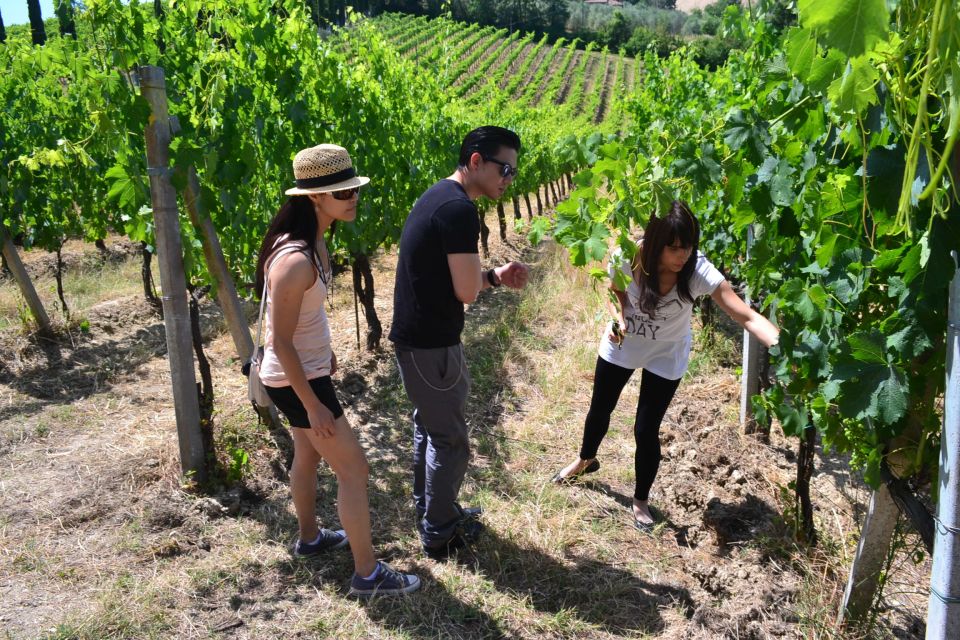
Beginning the 7-hour tour, travelers depart from Piazza dei Cavalleggeri, 1 in Florence and embark on their journey.
The first stop is in San Gimignano , where participants enjoy a 45-minute self-guided tour of the historic town.
Next, the group visits two Tuscan wineries, spending one hour at each location for wine tasting .
Afterward, they indulge in a 2-hour lunch in the Chianti Hills , savoring the regional cuisine.
The tour concludes with an additional hour of wine tasting in the Chianti region before the return van travel to Florence.
Inclusions and Transportation
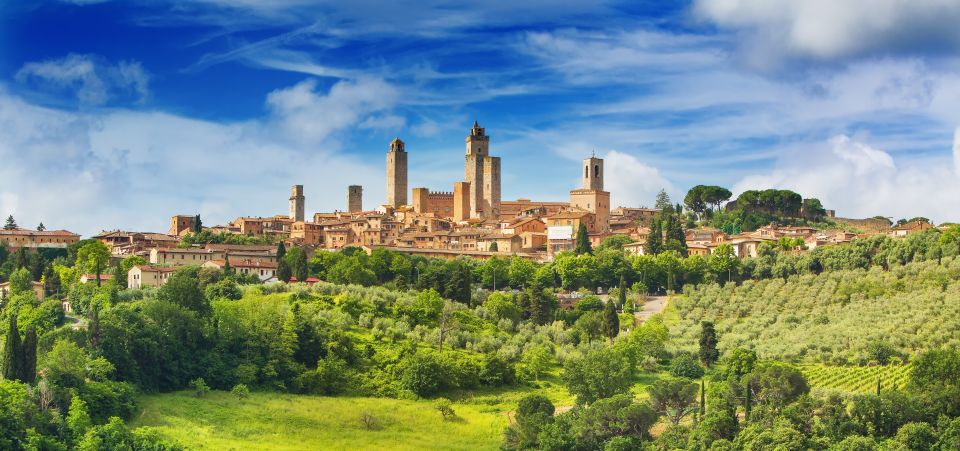
As the tour includes a range of services, participants can expect their experience to be comprehensive. The package includes wine tasting fees, a delicious lunch in the Chianti Hills, an expert tour guide, and round-trip transportation by minivan. Plus, hotel pick-up and drop-off, as well as tips, are all covered, ensuring a seamless and carefree day.
The meeting point for the tour is conveniently located at Piazza Cavalleggeri in Florence, in front of the staircase of the Biblioteca Nazionale. This comprehensive offering, combined with the small group size, allows for a personalized and immersive exploration of the Tuscan wine region.
Participant Information
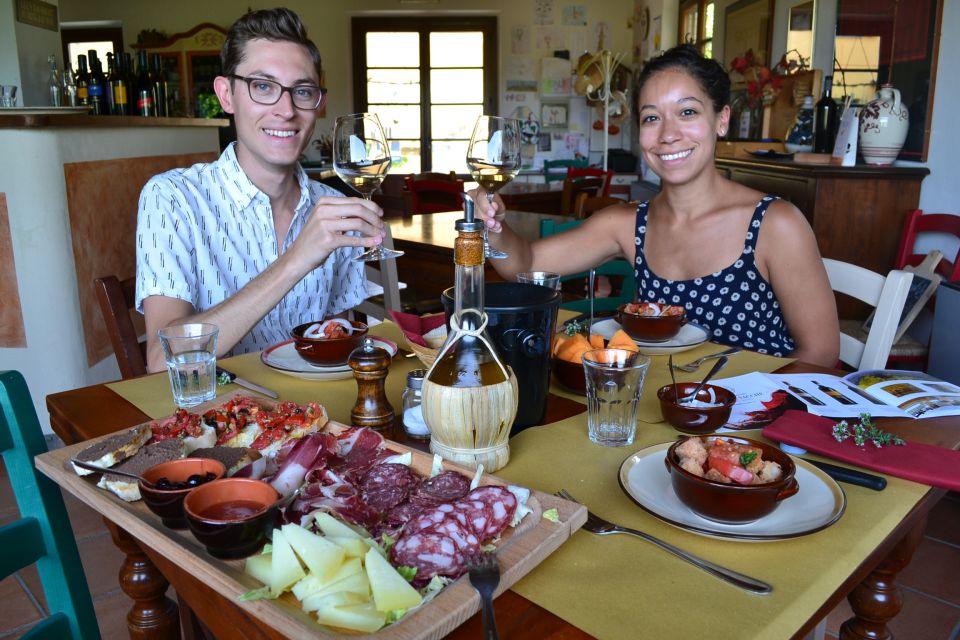
Participants for this Tuscany wine tour must meet certain criteria. The tour isn’t suitable for wheelchair users, people with mobility impairments, or pregnant women. The tour is open to adults aged 99 and younger.
Participants can expect:
- A small group size, limited to 8 people, ensuring a more intimate and personalized experience .
- Convenient hotel pick-up and drop-off, making transportation seamless.
- A knowledgeable tour guide to provide insights and enhance the overall enjoyment of the tour.
With these participant requirements in mind, travelers can look forward to an unforgettable journey through the picturesque Tuscan hills and vineyards.
Customer Reviews and Ratings
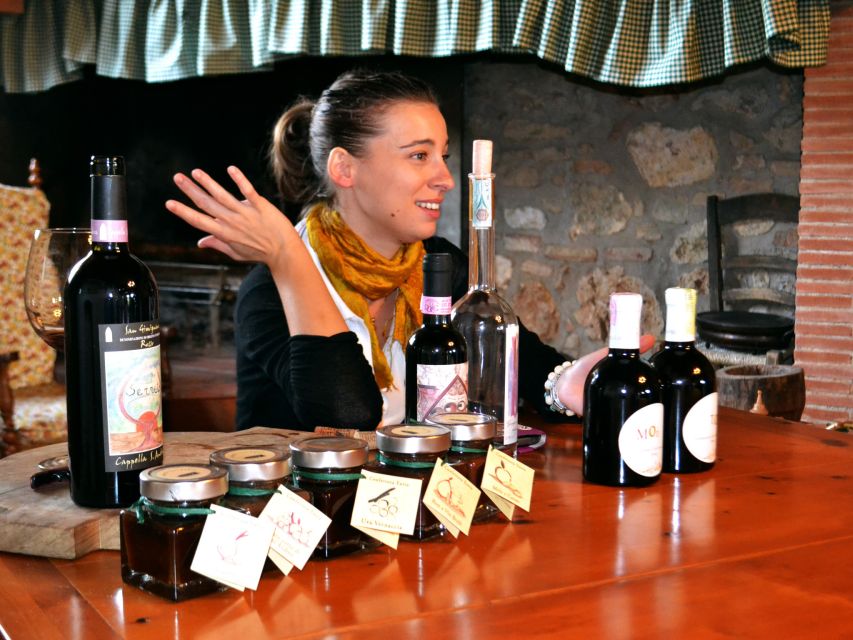
The Tuscany wine tour boasts an impressive overall rating of 5/5 based on 2 reviews. Reviewers praised the excellent value for money, safety, service, and organization of the tour. As one reviewer, Nicholas, noted, the tour offered "beautiful scenery and knowledgeable staff." Another reviewer, Teresa, described it as an "unforgettable experience thanks to an excellent guide, Matteo."
These positive reviews highlight the high-quality experience this Tuscany wine tour provides.
Explore San Gimignano’s Historic Charm
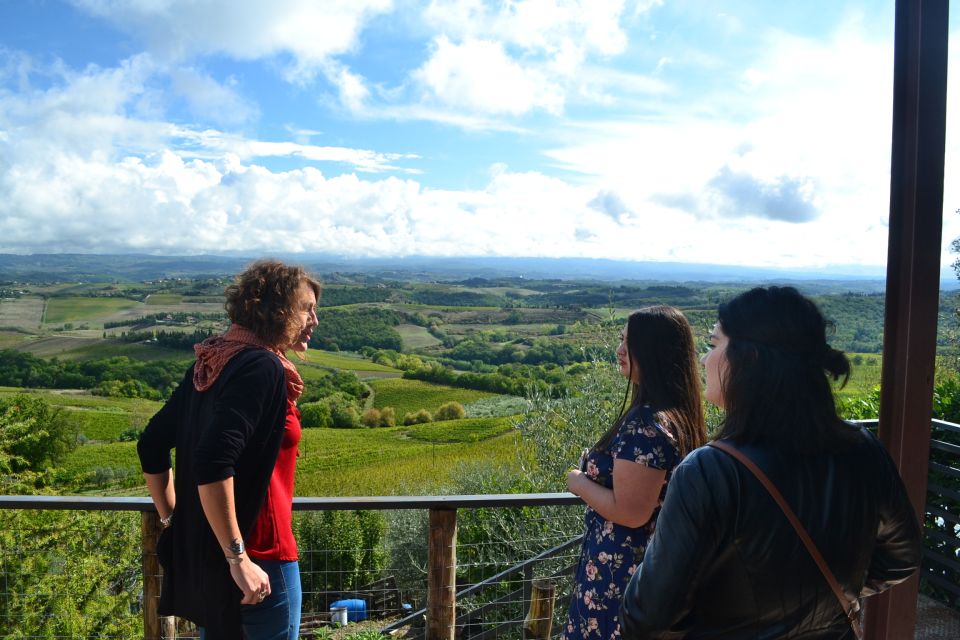
Visitors to the tour can look forward to exploring the historic charm of San Gimignano, a medieval town renowned for its striking skyline of soaring towers.
This UNESCO World Heritage site offers a glimpse into the past, with its well-preserved architecture , charming piazzas, and quaint shops.
Guests will have the opportunity to:
- Wander through the town’s narrow, winding streets, lined with medieval buildings and towering stone structures.
- Marvel at the iconic 14th-century towers , some of which stand over 50 meters tall, offering panoramic views of the surrounding Tuscan countryside.
- Discover the town’s rich history , including its role as an important stop along the ancient Via Francigena pilgrimage route.
Savor Chianti’s Renowned Wines
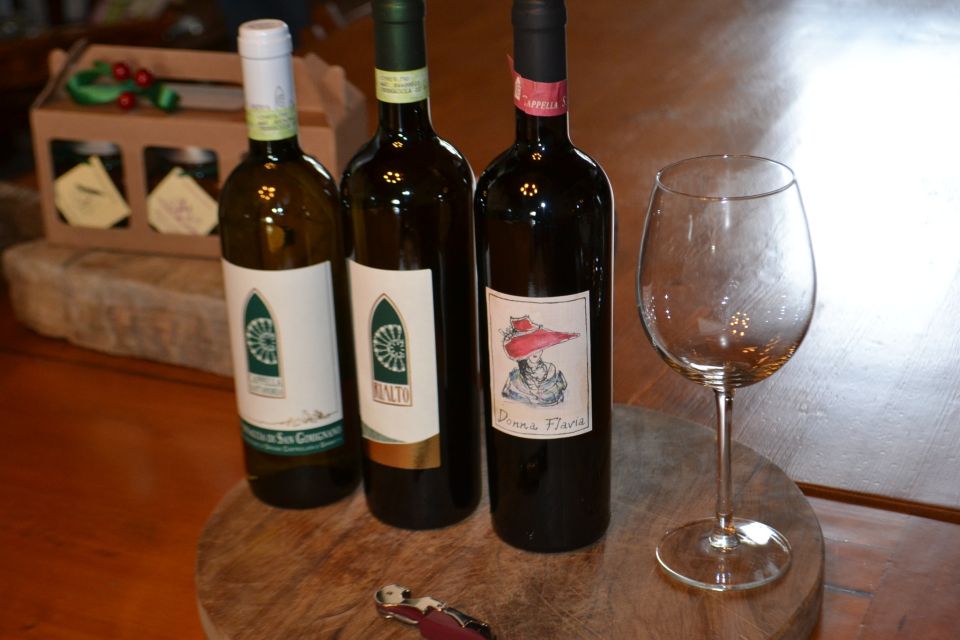
After exploring the historic charm of San Gimignano, you will savor the renowned wines of Chianti. The tour visits two wineries in the Tuscan hills, where guests will have the opportunity to taste Chianti red wine and Vernaccia di San Gimignano white wine. During the wine tastings, participants can learn about the winemaking process and the unique terroir of the region.
The Chianti wine tasting is followed by a leisurely lunch in the Chianti Hills, allowing participants to fully enjoy the Tuscan gastronomic experience.
Lunch in the Tuscan Hills
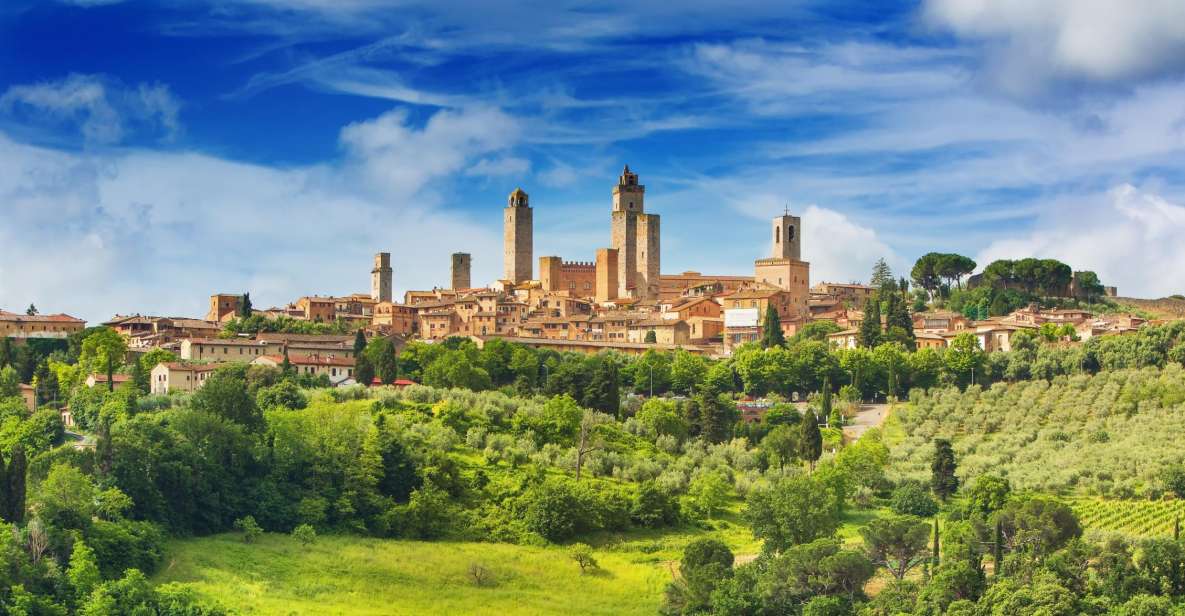
During the tour, participants enjoy a leisurely lunch in the picturesque Chianti Hills . The meal is served at a traditional Tuscan farmhouse , nestled amidst vineyards and olive groves.
The lunch features:
- A selection of regional specialties , including hand-crafted pasta, locally sourced meats, and fresh seasonal produce.
- Complementary Chianti wines , allowing guests to savor the flavors that have made this region renowned.
- A tranquil atmosphere, providing an opportunity to soak in the stunning Tuscan landscape and connect with the local culture.
This lunch break offers a delightful respite, recharging participants before continuing their exploration of the Chianti and San Gimignano wine country.
Here's a few more nearby tours and experiences we think you'll like.
- Florence Pizza or Pasta Class With Gelato Making at a Tuscan Farm
- Small-Group Wine Tasting Experience in the Tuscan Countryside
- Cooking Class and Lunch at a Tuscan Farmhouse With Local Market Tour From Florence
- Chianti Safari: Tuscan Villas With Vineyards, Cheese, Wine & Lunch From Florence
- Florence Vespa Tour: Tuscan Hills and Italian Cuisine
- Uffizi Gallery Small Group Tour With Guide
Frequently Asked Questions
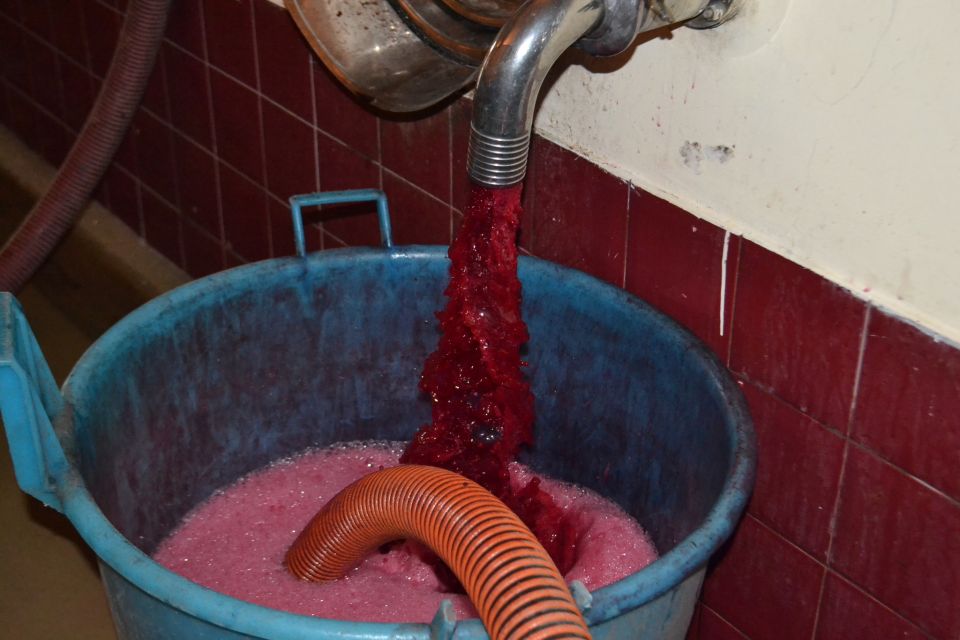
Can I Bring My Own Food and Drinks on the Tour?
The tour does not allow participants to bring their own food and drinks. All meals and beverages are provided as part of the tour package, which includes a winery lunch and wine tastings.
Are There Any Dietary Restrictions for the Included Lunch?
The tour’s included lunch accommodates various dietary restrictions. Travelers with vegetarian, vegan, or gluten-free requirements can be catered for by notifying the operator in advance. There are options to suit most dietary needs for the provided Tuscan-style meal.
What Is the Dress Code for the Wine Tastings?
The tour’s wine tastings have a casual dress code. Participants can wear comfortable, weather-appropriate clothing, as the focus is on enjoying the wines rather than adhering to a specific dress code. Formal attire is not required.
How Much Walking Is Involved During the Tour?
There is moderate walking involved in the tour, with about 45 minutes set aside for a self-guided tour of San Gimignano. The rest of the itinerary involves van travel and seated activities like wine tastings and lunch.
Is There an Option to Extend the Tour or Add Additional Activities?
The tour does not appear to offer an option to extend or add additional activities. The itinerary and duration are fixed at 7 hours. Guests should plan accordingly, as there’s no flexibility to customize the experience.
Not for you? Here's more of our most recent tour reviews happening neaby
- Florence in a Day: Small Group Tour With Uffizi and David
- Florence: Valdorcia Wine, Brunello Montalcino, Montepulciano
- Michelangelo and Santa Croce Private Tour
- From Florence: PRIVATE Wine Experience in Chianti Classico
- Private Tour: Visit Siena and the Rolling Hills of Chianti.
- Florence: Accademia Gallery and Free City Walking Tour
- Florence: Guided Tour of Medici Family Secrets and Chapels
- From Rome: Florence and Pisa Day Tour With Accademia Ticket
- Florence: Private Guided Walking Tour
- Private Florence Walking Tour With an Expert Local Guide
- Florence Private Walking Tour
- Rent Your Electric Vespa 45 in Florence for 8 Hours
- Private Day Trip Leonardos Birthplace From Florence + Lunch
- Florence: Horse Ride 3h and Wine Tasting&Lunch at a Castle
- Pasta Making Class at a 12th Century Winery in the Tuscan Countryside
This Chianti and San Gimignano wine tour from Florence offers a delightful glimpse into the enchanting beauty of Tuscany. With a self-guided exploration of the historic San Gimignano, exquisite wine tastings , and a traditional Tuscan lunch , it promises an unforgettable culinary adventure. The small-group setting and expert guidance ensure a personalized and memorable experience in the heart of Italy’s renowned wine region.
Similar Posts

Full Day Excursion to Machu Picchu From Cuzco

Hard Rock Cafe Venice With Set Lunch or Dinner

Munich: Bohème Schwabing Self-guided Neighbourhood Walk

Knuckles Leopard Trail Trek From Kandy

Munich 1.5-Hour Introductory Segway Tour
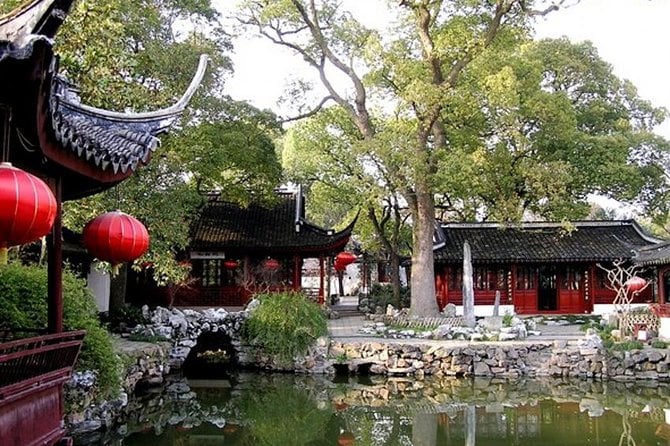
4-Hour Shanghai City Private Flexible Tour in Your Way
- Find Your Food & Drink Experience
- Food Tours Resources
- Private Dining Resources
- Team Building Events Resources
- Client Entertainment Resources
- Conferences & Activations Resources
- Birthday Party Resources
- Date Night Resources
- Bachelorette Party Resources
- Holiday Party Resources
- DEI Resources
- Gifting Resources
- Custom Events Resources
- Virtual Event Resources
- Types of Experiences
- Los Angeles
- New York City
- San Francisco
- Virtual Events
- Silicon Valley
- Washington DC
- Corporate Team Building Events
- Client Entertainment
- Conferences & Activations
- Birthday Party
- ❤️ Hispanic Heritage Month
- ❄️ Holidays
- Interactive Meals
- Private Dining
- Custom Events & On-Site Activations
- Experience Kits

Self-Guided Chinatown Food Tour in San Francisco
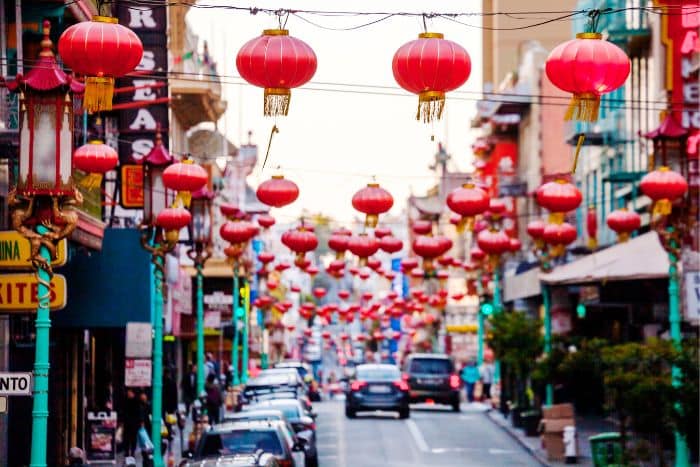
On this Self-Guided Chinatown Food Tour San Francisco, you will be taken away from the “tourist traps” and will get a glimpse into how everyday locals feast. You will get to taste a variety of dishes from different Chinese regions, both traditional and modern. Let us show you the hidden culinary side of Chinatown!
Self-Guided Chinatown Food Tour San Francisco Overview

1: Welcome Drink at China Live
China Live 644 Broadway

2: Course 1 at Good Mong Kok
Good Mong Kok 1039 Stockton St

3: Ross Alley & Golden Gate Fortune Cookie Factory
56 Ross Alley

4: Course 2 at Z&Y Restaurant
Z&Y Restaurant 655 Jackson St

5: Portmouth Square
Portmouth Square

6: Course 3 at Sam Wo or Capital Restaurant
Sam Wo (except Tuesdays or afternoons) 713 Clay St
Capital Restaurant (on Tuesdays and afternoons) 839 Clay St

7: Waverly Place
Waverly Place

8: Dessert at Dragon Papa
Dragon Papa 752 Grant Ave
Chinatown Self-Guided Tour Map
1: china live.
China Live, Broadway, San Francisco, CA, USA
2: Good Mong Kok
Good Mong Kok Bakery, Stockton Street, San Francisco, CA, USA
Golden Gate Fortune Cookie Factory, Ross Alley, San Francisco, CA, USA
4: Z&Y Restaurant
Z & Y Restaurant, Jackson Street, San Francisco, CA, USA
5: Portsmouth Square
Portsmouth Square, Kearny Street, San Francisco, CA, USA
Sam Wo Restaurant, Clay Street, San Francisco, CA, USA
6: Capital Restaurant
Capital Restaurant, Clay Street, San Francisco, CA, USA
Chinatown, San Francisco, CA, USA
8: Garden Bakery
Garden Bakery, Jackson Street, San Francisco, CA, USA
Here’s some tips to keep in handy before you start your experience:
- All of the selected dishes we recommend eating at each restaurant only budgets the base price; tax and tip are not included
- Many of the restaurants and stores are cash only, so be sure to stop by an ATM
- If you do happen to go during the weekday lunch rush or weekend dinner rush, be prepared to wait for seating at some of these restaurants
- If at all possible, call Z&Y Restaurant when starting your experience to make a reservation
- Please let your server know if you have any food allergies
- Don’t be afraid of the language barrier, most merchants speak great English
- How to say thank you: Xiexie (pronounced shi-eh shi-eh)
- Parking is tough here. Metered parking and garage parking can be pricey. We recommend taking public transportation. https://goo.gl/maps/Npf54Bjf6152
- Wear comfortable shoes. This route is precisely 1 mile along even pavement, but some parts do have a small incline.
- Bring a jacket. San Francisco weather can be hot one second, and freezing the next, so be sure to dress in layers.
Tour Introduction
San Francisco’s Chinatown is filled with colorful alleyways and streets, some with unusual smells and some with kitschy souvenirs. However, behind the Dragon Gates and pagoda rooftops is a vibrant neighborhood, which is home to gener- ations of Chinese American immigrants and a new evolving Chinese American cuisine. Before your journey begins, let us tell you just how the oldest Chinatown in Northern America began, and the Chinese cuisine within.
The first example of Chinese American cuisine emerged in 1848, at the beginning of the Gold Rush Era. Many young bachelors, mostly from the Cantonese region of China, flocked to San Francisco to take part in the search for gold. After the frenzy, many of these young men decided to stay in San Francisco as there was a high demand for their cheap labor. At the end of a long hard day’s work, many gold miners would congregate at eateries for dinner and drinks. Later, after the miners had finished their dinner, the hungry and tired Chinese workers would arrive at the eateries, but by then, the staff were tired, and kitchens were out of most ingredients. At that point in the evening, the chef would just throw together whatever food scraps he had left in the kitchen and called it a meal. This dish eventually become known as one of the first famous Chinese American dishes: Chop Suey.
Chinese men who arrived during the Gold Rush were not welcomed in San Francisco. Their appearance was different from the white men with long braided ponytails, different skin color. Speaking a foreign language, didn’t help either.
Because there were few available jobs, the white man’s verbal discrimination turned into violence, forcing the Chinese to self-segregate within the safety of their own neighborhood. Racism became so intense that the Chinese population would leave Chinatown for work then rush back at night to stay safe. This intense xenophobia led to the enactment of the Chinese Exclusion Act of 1882, which made it very difficult for anyone from China to immigrate to the United States or for American born Chinese to even become citizens.
Tension remained high for many years until the great earthquake of 1906 – a blessing in disguise to the Chinese community. The neighborhood was burnt down to ashes and dust. Chinatown was destroyed and this provided a chance to rebuild the community into something better, something more beautiful. City officials required that the newly built neighborhood had to be an asset to the city, so the Chinese saw this as an opportunity to design buildings catering to what Americans imagined “ethnic” China was like. More and more tourist began to pour into this newly rebuilt neighborhood and it was no longer labeled as a “slum”.
As time went on, discrimination toward the Chinese lessened. Once the immigration laws were repealed in 1943, Chinese families came to America in search of a better life. Chinatown was now more densely populated by women and children in addition to working class men.
In 1960, Cecilia Chiang who later became known as the moth- er of Chinese American cuisine, moved to San Francisco’s Chinatown. She originally came to visit her sister, who lived on the edge of Chinatown. One day, as she was walking down bustling Grant Avenue, she ran into some friends whom she had known while living in Japan. They were hoping to open up a Chinese restaurant, but needed Cecilia’s help as they didn’t know much about the cuisine. Her friends didn’t speak great English and didn’t even have checks to put a deposit down for the lease. So, Cecilia decided to help them out and wrote a $10,000 check. They eventually backed out. By law, the landlord was not obligated to give Cecilia her money back, thus, she was stuck with a restaurant lease.
How was this young lady with no restaurant experience going to run a restaurant herself? Having come from a wealthy lifestyle raised on food cooked by private chefs, Chiang had no cooking or restaurant experience but was determined to succeed. She noticed most so called “Chinese restaurants” were serving up dishes from the Gold Rush days like Chop Suey and Egg Foo Young, that didn’t taste very good. Chiang decided she wanted to be different compared to all the other Chinese restaurants in Chinatown and serve real, authentic Chinese food. She could only afford to hire a few staff including two cooks, an accountant, and a manager. Cecilia herself became the janitor, and the dishwasher, and did all the grocery shopping. With only the memories of what traditional Chinese cuisine tasted like, she tried her best to serve delicious and authentic dishes at her new restaurant, The Mandarin. At the time, many American were fascinated by this exotic cuisine, but wanted more dishes with familiar ingredients. She struggled to better understand the American palate and experimented with new menu items, sometimes changing menu items as frequently as every day.
After 2 years of being open, Cecilia began building regular clients, including Alexis Tangier, the owner of a high-class restaurant located in the wealthy Nob Hill neighborhood. He loved how different her food tasted compared to all the other Chinese restaurants he had eaten in and decided to introduce one of his friends, Journalist Herb Caen from The San Francisco Chronicle, to her restaurant. Caen instantly fell in love with Cecilia’s Chinese American dishes he had never tasted before. Soon after, he published a review about her cuisine that was widely read. As a result, the Mandarin became so popular, that Chiang had to relocate to a bigger, more elaborate space at Ghirardelli Square. Even until today, Chiang continues to influence the development of Chinese American cuisine.
Though she eventually sold The Mandarin (which later closed in 2006), Cecilia Chiang’s legacy continues. She has mentored famous chefs such as Julia Childs, James Beard, Alice Waters, and George Chen, who used to bus tables at her restaurant, and now owns the newest establishment in the neighborhood, China Live. Her son, Philip Chang, went on to co-open the fast casual Chinese American chain, P.F. Chang’s. In 2013, Chiang even won a James Beard Foundation Award for lifetime achievement. Cecilia Chang has truly become the mother of Chinese American Cuisine in America, which can still be seen today in San Francisco’s Chinatown’s restaurants.
Years of history is hidden behind Chinatown’s walls and unique flavors hidden in it’s countless dishes. This guide, designed by local foodies, for those wanting an insider’s look into one of San Francisco’s most famous neighborhoods, is all you will need to to explore the depths of the country’s first ever Chinatown – through its people, its history and its cuisine.
As you explore Chinatown with open eyes and ears, you’ll notice that Chinatown is continuing to evolve in new ways. For example, we look to two of the newest additions to Chinatown for the latest innovations – China Live and Mister Jiu’s. Both of these eateries are bringing something new and innovative to the community that Chinatown hasn’t seen before. Famous chefs like, Brandon Jew and George Chen, are diving into their heritage to showcase traditional dishes, but with a twist. Their menus change often, using the freshest, in season, local ingredients. This is only the beginning of a movement that will showcase Chinese American dishes in a different light, essentially interpreting flavors and ingredients that may scare some away. One could even call these new dishes Chinese-Californian cuisine.
Today we’re going to tell the story of Chinatown from a locals perspective that will showcase innovation juxtaposed with regionality, and tradition.

Image Credit: China Live Google Maps
Chinatown is a beautiful community with welcoming locals and delicious cuisine. Here at Avital Tours, we want to show you the backside – the locals perspective – that’s why we’re steering you away from the Dragon Gates, beginning your journey at the “back” of Chinatown.
China Live brings Chinatown something unique and innovative. Familiar with New York City’s Eataly? That’s the exact concept founder and world-renowned executive chef, George Chen, was going for. This project, which took about 3 years in the making and is still in progress to expand, is a one-of-a-kind food, drink, and retail emporium. China Live is an interactive culinary and cultural destination offering an in-depth exploration of Greater Chinese gastronomy. Here, Chen demystifies Chinese ingredients and recipes while educating guests on the rich history and influence. In describing his projected outcomes of this project, Chen states “I think this is the perfect place to kind of bridge the cultures across the oceans and the past to the present and future”. The menu is hyper seasonal and changes daily – truly producing only the freshest dishes and capturing California cuisine.
Take a step inside and discover what this establishment has to offer. The first thing you will see is the beautifully tiled Oolong Cafe. We welcome you to grab a cup of tea here as a welcome drink before furthering your exploration.
Next, you will pass by Bar Central. If you get thirsty at the end of your journey through Chinatown, come back and enjoy a Shanghai Kelly’s Bad Bad cocktail, a twist on the classic Pisco Punch, created by one of San Francisco’s favorite bartenders, Duggan McDonnell. McDonnell continues the legacy of Pisco in San Francisco, and takes pride in calling it one of the city’s preferred spirits since it was San Francisco’s most popular spirits during the Gold Rush. This Chinese-California cocktail of Encanto Pisco with Plantain Pineapple Rum, Blue Curaçao & Gun Powder Green Tea, Fresh Lime & Pineapple, and Orange Bitters, is not to miss.
Next, you’ll see the Market Restaurant. Look to the left, and take a peek inside the kitchen to see chef’s preparing one of our favorite dishes on the menu – the peking duck with a kumquat glaze and traditional condiments served in a sesame pocket. If you’re still feeling hungry after this self-guided tour, come back here to try this dish.
The other half of the first floor of China Live is a retail market. Here you can purchase a wide array of goods such as spices and imported cookware. Since opening day, locals have been filling up the dining space for a one of a kind dinner experience. China Live showcases the beginning of modern day Chinatown – bringing locals from all over the city to discover the growth of this amazing neighborhood.
After you enjoy your cup of tea from China Live, head out – side and take a left towards Stockton Street. Step away from Grant Avenue filled with materialist goods and souvenirs, and step into the local side of Chinatown. Even from afar you will notice the street bustling with overcrowded buses, locals running around grocery shopping, and quirky stores. Keep an eye out for your first course: Good Mong Kok.

Image Credit: Christine Kang via Google Maps
As you stumble down Stockton Street past the produce outlets, past the fish markets, and past the spice shops, you’ll notice this quaint, but bustling, no frills eatery. Here you can grab the best cheap dim sum in the neighborhood, which makes Good Mong Kok a local’s favorite. Be prepared to wait in line, but don’t worry, it moves fast and it’s definitely worth it.
Dim sum is a style of Chinese cuisine, particularly Cantonese, prepared as small bite-sized portions of food served in small steamer baskets or on small plates. Most of the Chinese who immigrated to San Francisco were from Guangdong Province, a Cantonese region, and thus brought their regional dishes with them to San Francisco. Freshly made and served on carts that went around the restaurant for customers to choose from, this style of dining became a tourist attraction. Americans soon grew fond of the little hors d’oeuvres, eating them in restaurants and eventually grabbing some as a snack on-the-go.
Chef Bo Cina from District Oakland restaurant recommends “the pork and vegetable Cha Siu Bao (though the bbq pork version is also great), the perfectly seasoned shrimp Har gow (Xia Jiao) with bamboo shoots, and don’t forget the soy and Hunan chili paste”. We love the perfectly balanced peanut and pork dumplings (Fung Gow) too! You just might have to come back later to try the shu mai and steamed pork buns as well!
The staff are used to many tourists and locals, so don’t be afraid to ask questions if you don’t know what something is. If anything, just point to choose what you want, we guarantee you’ll find just about everything to be delicious. We’re unsure if it’s just the tasty sesame balls or because you can feed yourself under $5 here, but Good Mong Kok is not a spot to miss.
Next, you will discover the history of Ross Alley and learn the story of the fortune cookie. Take a left out of the restaurant and follow the map to your next destination.

Image Credit: lonelyplanet.com
As you remember, the Chinese retreated to their neighbor- hood due to vast amounts of outside discrimination. Imagine how bored Chinatown residents must have become confined to a few square blocks. Thus, to entertain themselves, notorious pastimes, such as gambling, prostitution and drug use emerged.
Fun fact: Ross Alley is the oldest alley in Chinatown, dating back to the times of the Gold Rush. Between the 1860’s up until 1906, small alleys like this were notorious for slave auctions, brothels, opium dens, and gambling halls. This was probably not the place you would have hung out at the time (or maybe you would have….)
During the late 1800’s, Chinatown consisted mostly of bachelors; there was actually only a very small population of women. To fulfill needs of intimacy, most women at the time were actually brought overseas by “gangs” to be sold in slave auctions that took place in small alleys like this or taken into custody at brothels.
Another commodity at the time was Opium, a very popular drug in China, enjoyed for leisure by all levels of society. The first shipment of Chinese opium arrived in San Francisco in 1861. A few years later, 1864, became known as “the Year of Opium” in San Francisco, as huge shipments were arriving regularly. Though it was illegal, laws were not strictly enforced except when the police needed to scheme for money. Secret opium “dens” were created to hide from cops. A typical opium den might have been a Chinese-run laundry that had a basement, back room, or upstairs room that was tightly sealed to keep drafts from making the opium lamps flicker or allowing the opium fumes to escape – always hidden in small side alleys like this. However, during the 1906 earthquake and fire, all of these dens were wiped out and were never rebuilt.
Gambling was yet another bustle to pass the time. Throughout alleys, windows would be boarded shut, but you could still hear the echo of Mahjong, a tile-based game that originated in China. The sounds of tile pieces and coins being tossed around constantly rang throughout the neighborhood. This to was an illegal pastime that often caused tension between “gangs.”
Golden Gate Fortune Cookie Factory
Tucked away in this tiny alley is the last standing handmade fortune cookie factory in America. Follow the scent of freshly made sweets and you’ll know you’re in the right spot. The ironic part about the fortune cookies served in Chinese restaurants after meals, is that their origin actually lays with the Japanese. Here’s the inside scoop!
The fortune cookie was invented by a Japanese immigrant named Makoto Hagiwara. In 1895, he came to design, manage, and live at the Japanese Tea Garden in the city’s Golden Gate Park. As a way to entice customers, and show his gratitude for their visit, he gave out Japanese fortune tea cookies with “thank you” notes inside. Their shape is supposed to evoke that of the bells at temples where people prayed for health and good fortune, and to also resemble the look of a bow. The fortunes on the other hand, just acted as souvenirs for travelers. Though a baker, Hagiwara outsourced the production to Benkyodo, a small Japanese bakery in San Francisco’s Japantown. Chinese restaurants then began to use these cookies as “thank you” gifts to their diners as well. This became very popular and soon many Chinese restaurants made this a staple at the end of each meal. Due to the 1942 Japanese internment, Benkyodo was taken over by enterprising Chinese businessmen who saw this a growing business amongst their culture.
Modern day Ross Alley is now known as the site of the The Golden Gate Fortune Cookie Factory, which is now owned by Franklin Yee and opened in 1962. Even from down the street, you can smell the sweet scent of freshly made, warm, heavenly, cookies. Today, about 20,000 cookies are handmade a day by two women manning what you will see to be a very large piece of machinery. Once you walk in, take a bite into one of the complimentary reject cookies and you’ll get a fresh taste of a buttery-sesame mixture. It’s free admission to walk in, watch, and have a sample, but if you want to take a picture, remember it costs 50 cents.
While we love the story of the Fortune Cookie being invented in San Francisco, some historians claim that they were invented in Los Angeles. So, in 1983, San Francisco’s pseudo-legal Court of Historical Review held a mock trial to determine the origins of the fortune cookie. To no one’s surprise, the judge (a real-life federal judge from San Francisco) ruled in favor of San Francisco. Included among the evidence was a fortune cookie whose message read: “S.F. Judge who rules for L.A. Not Very Smart Cookie.”
You will now head towards the second course of your experience to get a feel for one of China’s seven regional cuisine styles. Head back towards Jackson St. and walk over one block to the next restaurant.
Image Credit: Z&Y Restaurant Google Maps
Z&Y restaurant is our restaurant of choice for authentic Szechuan style cuisine. Though Cantonese dishes are prominent in San Francisco’s Chinatown, it’s important to note that there are actually 7 regional cuisines in China. Szechuan cuisine, originating from the Sichuan province in southwestern China has particular pungency and spicy bold flavours resulting from the use of garlic and chili peppers, as well as the unique flavor of the Sichuan pepper. Be careful, this place takes spice to a whole new tingling-numbing level. Owner and chef, Han Lijuan and his wife opened up this restaurant 9 years ago to showcase great Szechuan cuisines to a Cantonese filled neighborhood. Bringing the heat with his Northern Chinese dishes infused with Szechuan flavors, Chef Han has lovingly opened a restaurant that locals from all over the bay flock to in order to get their fix of hot and cold dishes infused with spicy peppercorn chili, served family style. Not only has Chef Han served prestigious guests, such as presidents and prime ministers of the People’s Republic of China, but his restaurant has actually made the list for the top 100 restaurants in San Francisco and is even a Michelin 2017 Bib Gourmand restaurant.
Our favorite dish is hands down the Wontons with Spicy Peanut Sauce. Also a favorite of Chef Joshua Skenes from Michelin 3-starred San Francisco restaurant, Saison, he jokingly says these dumplings are “spicy like (his) wife. They have a thin skin so they’re not dumplings in a traditional sense, but more like wontons. There’s a sauce made from chilies, soy sauce, and vinegar and its just sweet, salty, sour, and spicy.” For vegetarians, or if you have a larger group and want to order more food, the House Cold Noodles is a great addition to your progressive meal. This cold dish combines cucumber, beansprouts, and noodles of course, infused with chili oil.
Next, to get a feel of how everyday locals use their leisurely time, we will take you to Portsmouth Square. Follow the map to your next destination.

Image Credit: LauraDel via Flickr
Portsmouth Square also known as the “Heart of Chinatown” and “Chinatown’s Living Room” plays an important role in this neighborhood. Just walk in during the middle of the day and you will see the area bustling with Tai Chi and Falun Gong practitioners, and neighborhood locals playing Chinese checkers, cards, hanging out, sharing snacks, and socializing with one another. This square played an import- ant part in history as well – it was the location where the discovery of gold was announced and also where the first public school in California for non-whites was built.
You must be wondering why Portsmouth Square is called a living room? Well, most of the apartments in this area are single rooms, with a history dating back to the 1850’s. Back then, there was many young adults who migrated here that could not afford the Foreigner Tax, which was required before they could head up to the gold fields. Instead of heading back to China after such a long migration, they settled in Chinatown. Since they were single, young men, they did not need space to entertain guests or full kitchens, so most of the apartments were built with just one large room. The original studio apartment, so to speak.
So, Portsmouth Square became Chinatown’s “living room”, as a lot of young Chinese hung out there. Like we mentioned before, there was little to no entertainment in the area, so life here was boring and dull, and the highlight of any day was probably hanging out in Portsmouth Square. Today, many of the SRO’s house newly immigrated Chinese and the older Chinese population as they are very affordable. To this day, you can see that the square still acts as an entertainment space for the older Chinese crowd.
In our mission to create community, we stumbled across a friendly looking older gentleman soaking in the sun. When we asked Mr. Alan Wong about his memories of the history of Chinese American food while growing up, he lit up and glared at his bag of french fries that he was holding. He told us of the time when the now closed Fong Fong Bakery & Soda Fountain used to be the go to spot. “When I was younger, my parents were extremely poor. Sometimes if they had enough money to get by for the week, they would give my brothers and I some spare change. This was our favorite place to go when we had money – it was a luxury for us.” He told us he could purchase 3 orders of french fries and lychee ice cream for the same amount of the bag of fries he was currently holding in his hands. Though he has seen many Chinese American dishes come and go Mr. Wong claimed “I’m happy to see how things have changed for the better since I was younger”. He even went on to mention that nowadays, some of his favorite places include New Lung Ting and Capital Restaurant!
For your third course, you will taste traditional Cantonese comfort food. You have the choice of a BBQ Pork Rice Noodle Roll at Sam Wo or Salt and Hot Pepper Fried Chicken Wings at Capital Restaurant. Once you have decided, follow the map to either restaurant of your choice.

Image Credit: Chris Perez via Google Maps
The infamous Sam Wo dates back to 1907. This restaurant has been the place to go for late meals after a night out for about 100 years now. Generations and generations of locals have flocked here to get their inexpensive fix of Barbeque Pork Rice Noodle Rolls and Jook. This is one of those famous, no-frills, late-night food fixes that has it’s “you-get-what- you-get service”.
Unfortunately in 2012, the original location was closed down after having its health permit suspended. With years of history behind them and the demand of loyal customers, Julie Ho, daughter of the owner, revived the restaurant at a new location. At this current location, the food is truly still the same home cooked style comfort food it has always been, however the decor takes on a more contemporary meets old school feel. The dishes served here are the definition of Chinese comfort food. The restaurant’s most popular dish, and quite frankly our favorite as well, is the BBQ Pork Noodle Rice Roll. Ask for spicy mustard on the side, but be careful, a little bit goes a long way. For our vegetarian guests, we recommend the plain jook with a chinese doughnut on the side! This classic Chinese breakfast combo is the ultimate comfort meal.
If you happen to drink one too many Chinese Mai Tai’s tonight, circle back to Sam Wo for your late night indulgence. Tip: If you get the chance, stop by the original location at 713 Clay St to get a true feel of this restaurant’s years of history.
Note: Sam Wo is closed on Tuesdays and some- times closes between lunch and dinner hours. If this happens to be a time you’re on your self guided experience, head over to Capital Restaurant instead for more Chinese comfort food. Or if you just simply rather eat Fried Chicken Wings instead of a BBQ Pork Rice Noodle Roll, we say head over there too.
Capital Restaurant
Capital Restaurant is your local no frills restaurant serving up traditional Cantonese and Chinese-American dishes. It may look like the interior hasn’t been upgraded since the 1970’s, with scotch tape covering up the degrading wooden table panelings, but that definitely doesn’t take away from the pleasingly unpretentious food. The simple decor matches the simple yet delicious food that mom used to make when you were younger.
Owner Samantha Lo intentionally placed the restaurant’s best selling dish, the Salt and Hot Pepper Chicken Wings, on the cover of the menu when she took over the restaurant from her mother-in-law in 2007. Definitely hard to miss when peer a the menu, but if you do, most of the time she’s already halfway to the table with your wings before you can even order.
Chef Staffan Terje from Barbacco favors these wings as well and says they’re “very tasty and versatile”. For our vegetarian friends, we recommend ordering the Braised Tofu with Black Mushroom and Greens. Capital Restaurant isn’t here to impress the ultra-foodies, but rather to satisfy your Wednesday night take-out needs.
Note: Capital Restaurant is closed on Mondays. If this happens to be the day you’re on your self guided experience, head over to Sam Wo instead for more Chinese comfort food. Or if you just simply rather eat a BBQ Pork Rice Noodle Roll instead of Fried Chicken Wings, we say head over there too.
Next you will learn the meaning behind the architecture, temples, and many surnames you’ve seen throughout Chinatown thus far. Follow the map to your next destination, the picturesque Waverly Place.
A picturesque street full of sights and smells to overwhelm you, Waverly Place houses a multitude of restaurants and temples. Just look around and you will see a great deal of beautiful architecture. Many Tongs and Family Association gathering spaces, a piece of history very unique to the Chinese community, also line this street.
Look about and ponder “The Street of Painted Balconies”. Away from the tourist front, this has to be one of the most beautiful, little local streets of Chinatown. Pops of green, yellow, red, and pink coat the beautifully crafted buildings. Peer at the many balconies, and notice how they unusually point upwards; these were especially designed this way to ward off spirits.
Located on the top floor of many of these picturesque buildings, are the meeting spaces of what Chinatown calls “Tongs”. Tongs are associations that formed within Chinese immigrant communities around the 1800s. They were essentially assembled in Chinatown to help the community with legal, monetary, and protective services, because they weren’t able to use “white” services. However, the Tongs slowly became known for criminal enterprises, trafficking in drugs, prostitution, gambling and even slavery. Soon, many Tongs formed affiliations with the gangs within Chinatown. Remember the leisurely activities bachelors took interest in the olden days on streets like Ross Alley? These were typically controlled and run by the gangs or Tongs. Today, there are still a handful of of Tongs. However, activity is now much quieter and behind the scenes.
On the lighter side, you will also notice common Chinese surnames such as Wong, Fong, Chan or Louie, plastered on a few buildings. These house the whereabouts of Family Associations, societies formed around a family surname. Chinese descendants that hold the same surname are entitled to the services their specific Family Association offers. Earlier Family Associations attempted to discourage prostitution, encouraged the Chinese to live moral lives, and fought for higher wages for immigrants competing with “whites” for labor. Today, they provide family descendants with community services, money in times of need, scholar- ships, share family history or news, and host family reunions. When we talked to Mr. Lee, he gloated that his family name is actually the largest in San Francisco’s Chinatown. He went on to mention “generations ago, our family association community helped my family settle in Chinatown. They offered assistance in finding cheap housing, helped some of my family learn English, and aided us in finding fair jobs. Before I entered college, I even got assistance with applying for scholarships, and am now able to contribute back to my family.”
Lastly, if you look closely at the some signs, you will notice that some of the buildings house temples. These are not elaborately labeled like other places of worship, as the importance of the structure lies in the prayers to the gods rather than the outdoor decor. If you’re up for it, we welcome you to #BreatheCuriosity and explore the Tin How Temple. This happens to be the oldest Taoist temple in Chinatown, which opened in 1852. The Tin How Temple was originally established in this neighborhood so those who traveled to America overseas could give thanks to goddesses for protecting their journey. Here locals pray to the goddess of the sea, burn incense, and have their fortunes read. The building is accessible to the public for free, but note you will have to take the stairs up a few floors.
Update: Dragon Papa has sadly shut their doors. We will be updating our dessert stop soon. In the meantime, check out the option stops section for more dessert ideas.
Your final stop on this experience concludes at Dragon Papa, a one of a kind dessert shop, show included. This little shop is the only one in San Francisco that makes the freshly pulled dragon beard dessert. In fact, there’s only one other producer of this dessert on the West Coast, truly a nearly lost art. Once you walk in, you will be greeted by the store owner, Derek Tran, a seemingly young male too young to run a shop himself. We talked to Derek, who told us he’s actually a fourth generation Dragon Beard maker, and car- ries on the tradition of his great grandfather – a chef in the Forbidden Palace in Beijing where he specialized in preparing Dragon Beard candy for the emperor’s court. Derek’s father originally made Dragon’s Beard candy at the famous Koi Palace in Daly City, but the two have since ventured out on their own. Locals love this spot as it’s a dessert from their homeland that they can’t get anywhere else. Elder residents as well are even happy to find their favorite childhood treats.
You can enjoy watching the dessert creators from the storefront window twist and stretch a thick ring of malt syrup until it forms hundreds of thousands of silky white strands. The candy, that looks like a sort of cotton candy floss, is coated around a mix of toasted peanuts, sesame seeds, and coconut. As each dessert is meticulously hand crafted, only 7 boxes per hour can be produced for a total of about per 60-65 boxes a day.
The name “Dragon Beard” derives from the mess you make when you eat it. Before delving in Derek told us “take a selfie after you eat it…white little strands hang from your mouth, making you look like you have a chinese folk lore dragon’s beard”. Here, they sell a few other Hong Kong treats, all made by hand, including ginger candy and warm mochi coated in seeds. The original flavor Dragon’s Beard dessert is definitely the dessert to order, but we also recommend trying the coffee flavor if you’re feeling adventurous. Derek is the most hospitable shop owner ever. He will be more than thrilled to tell you the history of the art, describe the candy making process, and describe all the flavors you will be tasting – so #BreatheCuriosity and ask!
Optional Stops
Li po cocktail lounge.
Li Po Cocktail Lounge is that peculiar dive bar that you typically wouldn’t enter. However, when Anthony Bourdain is a fan, why not give it a shot. We recommend ordering the highlight cocktail – a Chinese Mai Tai given that the original Mai Tai was invented in Oakland, across the bay. Chef Val Cantu from Michelin-starred restaurant, Californios, jokes that “the Mai Tai’s here will get you there much faster.” If it gets too busy at the main bar, there’s a hidden seating area downstairs that also has another bar.
New Lun Ting Cafe
New Lun Ting Cafe, also known as “The Porkchop House”, is a Hong-Kong style eatery serving comfort food that was established in 1970. Their most popular dishes consist of an unusual but delicious concoction of Cantonese, British, and American influence. Look around and you’ll mostly see plates of pork drenched in a classic burnt orange sauce served with a side of cabbage or corn. Some tend to even opt in for the classic spaghetti instead of the side of rice.
These days you’ll see the place packed with local families and older couples, but back in the 1970’s it was actually known as a “bachelor’s cafe” due to it’s single style seating usually populated by unmarried men. In the late 1980’s, table furnishings went from single seating to a more traditional family style seating. Though there’s still a table of single style seating that gets filled with loyal customers of bachelors, it’s now a spot for all locals to enjoy traditional, homemade, Chinese-American diner dishes.
Mister Jiu’s
Mister Jiu’s brings to chinatown innovative Chinese- California cuisine. This contemporary establishment twists Chinese traditions with artistry and organic/seasonal, local ingredients. Marcia from Tablehopper says that “Jew has learned the importance of knowing where [his] ingredients come from and isn’t inspired to buy dried scallops from a jar in a shop where he doesn’t know a thing about them or even how long they have been sitting around. It’s about the integrity of everything used in the kitchen, so the kitchen’s four dehydrators have been running full time.” Though just about every dish is amazing, we highly recommend pairing your food with one of their specialty cocktails, from bartender Danny Louie, named after symbols of good fortune.
Golden Gate Bakery
Golden Gate Bakery is the place to go in the city for Dan Tats, also known as Egg Tarts. The perpetual line out the door should be a clue that some sort of wizardry is going on inside this bakery. One of San Francisco’s iconic foods, the Egg Tarts here are amazingly fresh and warm, with flakey layers of dough, filled with an indescribable fluffy custard. Hold on before stuffing your face with this deliciousness! These treats routinely come right out of the oven, so be sure not to burn your tongue.
AA Bakery hits 3 birds with one stone – delicious pastries, intricate cakes, and home cooked food. Many neighborhood locals flock here to meet their elaborate cake needs as well as cravings for Hong-Kong style homemade food and pas- tries. Owner Henry Chen came to the States when he was 20 and dabbled in the food industry as a server and cook before landing in the pastry scene, where he’s been ever since. He enjoys making something out of nothing. “With baking, all you have is flour, sugar and eggs — you basically have nothing to start with, but can be very creative,” says Chen. Note the strong community vibe here; regulars hang out and chat while they sip on Hong Kong-style Milk Tea and pastries.
Chinese Cultural Center of San Francisco – Visual Arts Center
The mission of the CCC is dedicated to elevating under- served communities and giving voice to equality through education and contemporary art. Stop by to experience the beautiful rotating art exhibit.
Tour Conclusion
Avital Experiences wants to thank you for taking the the time to let us show you exactly why we love Chinatown. For years, this neighborhood has housed many great traditional Chinese-American restaurants, but it’s now also showing San Francisco’s culinary scene something new and innovative. We hope you enjoyed our recommendations and received a glimpse into how current day locals live in Chinatown. If you enjoyed this self-guided tour, we encourage you to tell your friends and family to try it out for themselves. Did you take any awesome photos? Share them at @avitalexperiences!
More Walking Food Tours with Avital
Enjoyed your self-guided experience in San Francisco and hungry for more? Book a guided tour with Avital in North Beach or the Mission District for even more incredible food, delicious drinks, and awesome stories!
Your Corporate Dining Experts
Traditional dinners are boring.
Avital dinners are awesome. We specialize in creating engaging dining experiences that make you look good. We have your back with seamless logistics, an all-star team, and charismatic hosts.
Client Engagement • Team Building • Parties
Find Your Experience
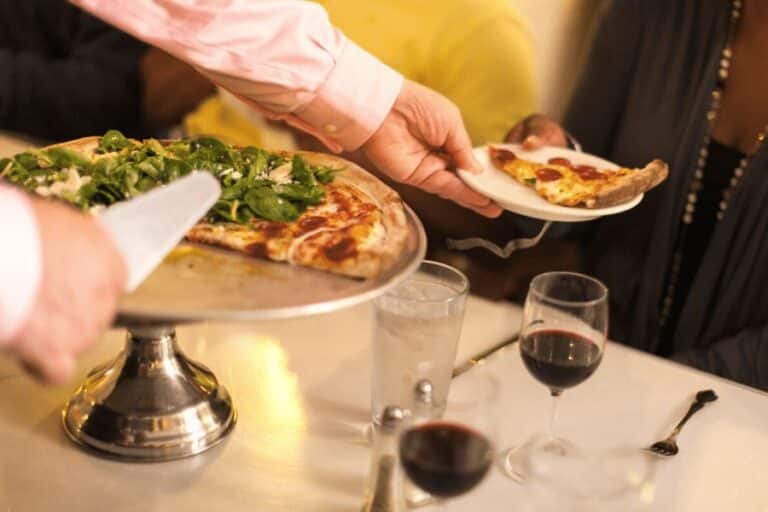
Ants in Pants
Blog about budget travel.

Ulan-Ude (Russia): Why Go to the Capital of Buryatia?
- By Anastasiya
- September 1, 2018

How to get to Ulan-Ude? A drill to know if you travel by Russian trains
It may seem that getting to Ulan-Ude is not that difficult: you either fly into it or take one of many trains from Irkutsk . Yet, there is one drill a traveler who is not originally from Russia would not know: the train timetables all over Russia are Moscow time, whether they are in Siberia or Saint-Petersburg. We did not read the tickets attentively and came to the railway station at 8 pm; to be honest, we ran into the station since we were late. However, we could not see our train on the timetable and asked for help; this is how we learned that our train would depart in six hours only. It is written in the tickets with very small letters that the departure time is Moscow time.
Where to stay
In the end, we came to Ulan-Ude at 11 AM and tried to find the guesthouse we booked from Booking. However, it turned out that this was the apartment and we had to wait for the administrator to bring the key. We spent a lot of money calling the administrator and ran out of the Internet; when she finally came, it turned out that the price in booking was per person, although we booked a “double.” Since we did not have any internet left to book anything else, we had to take it. Make sure you read the reviews well: the majority of “guesthouses” in Ulan-Ude are apartments with quite unpredictable policies.
The center of Ulan-Ude

How to get to Ivolginsky Datsan

Ivolginsky Datsan

You only need 5 to 7 hours to see the center of Ulan-Ude and Ivolginsky Datsan, which is why the city is great as a hub and a short stop on the way from Irkutsk to Mongolia. It feels so much like the city in between these two: it is still next to Baikal and in many ways is similar to Olkhon and Arshan , but is much more Buddhist, like Mongolia . From Ulan-Ude, we departed to Kyakhta, the city at Mongolia border and then to Mongolia.
You May Also Like

Sviyazhsk Island (Tatarstan, Russia), or How Ivan the Terrible Conquered Kazan

Mutnovskiy volcano (Kamchatka)

Yoshkar-Ola is Different: “The Land of Ancestors” Festival and Gulag Museum (Russia, Mari El)
No comments, leave a comment cancel reply.
Notify me of follow-up comments by email.
Notify me of new posts by email.

IMAGES
VIDEO
COMMENTS
Stop 3: 456 Shanghai Cuisine. Where: 69 Mott Street A, NYC. What: Pork soup dumplings. Cost: $5.99 for an order of 8. 456 Shanghai Cuisine was bustling at lunchtime but I got a table right away and immediately ordered the soup dumplings, which I couldn't leave Chinatown without. Most other parties also had an order of soup dumplings on their ...
The following is the first food tour that I put together from online research. We have taken it twice and modified the results based on our tastes. If you start out at 11:30AM when the first shop opens, it should take you most of the afternoon to complete. Enjoy. When we head into NYC from New Jersey we park in Jersey City by the Grove Street Path station and then take the Path over to the ...
ABOUT THE TOUR. Welcome to the Chinatown & Little Italy Secret Food Tour — the ultimate foodie adventure for pizza lovers and Asian cuisine enthusiasts alike! Get ready to experience the rich history, traditions, and flavors of New York City's most internationally recognized ethnic neighborhoods. Our 5-star cultural and gastronomic adventure ...
Use the Map and guide for attractions and a self guided food tour. Use the Chinatown New York google map below to visit the attractions in the historic neighborhood of Chinatown in New York. A complete guide to historic Chinatown including a Chinatown FOOD TOUR. Follow the walking route to explore the alley ways and narrow streets at your own ...
1. Stroll Mott Street. This is Chinatown's unofficial "Main Street" where many of the first Chinese-owned shops and restaurants opened in the early days of Chinatown. Today it is lined with Chinese restaurants, trendy bubble tea shops, and tourist-type gift shops.
Stop for a serving of five, now $1.25. Fried Dumpling. Labor back up the hill and turn right on Mott. Directly on your right is Hop Kee at 21 Mott and then the basement original of Wo Hop at 17 ...
New York City & The High Line - Self Guided Walking Tour. 7. from $9.88. New York City, New York. New York NYC Private Tour By Stretch Limo, SUV Or Luxury Van 3 HR. 79. from $797.00. ... Guided Food Tour of Chinatown and Little Italy. 1,747. 3 hours. Free Cancellation. From. $125.00. Soho, Little Italy, Chinatown Private Tour. 4. 2 hours 30 ...
Chinatown Food Tours with a Chef! Food and history tour! Over 700 five-star reviews! Taste the best of Chinatown! top of page (917) 628-4427. THE CHINATOWN EXPERIENCE. HOME. ABOUT CHAD. GALLERY. REVIEWS. CONTACT. More. Book Now. CHINATOWN FOOD TOURS. Join me on my walking food tour through Manhattan's Chinatown! ...
New York Chinatown Self guided Walking Tour - visit the popular attractions in Chinatown, including your own personal Chinatown food tour. Visit the popular local restaurants to sample the cuisine. Once you have completed the food tour and attractions tour in Chinatown. Use the guide to walk 15 min to the Brooklyn Bridge and complete the ...
On our Secret Food Tour: Chinatown and Little Italy, you'll experience New York City's most "Iconic" neighborhoods. Get ready to experience the rich history, traditions, and flavors of New York City's most internationally recognized ethnic neighborhoods. Our 5-star cultural and gastronomic adventure promises to be an experience that will leave you with a newfound appreciation for the city ...
When: Currently only available as a private tour. View Complete Tour Calendar. Cost: This tour is free to take, and you get to decide what, if anything, the tour was worth when it's done. A name-your-own-price tour is a tour for anyone's budget. Suggested amount to bring for snacks is $7-10, depending on your appetite.
CHINATOWN SELF-GUIDED FOOD TOUR. ... GEARY BOULEVARD GEARY STREET GEARY BOULEVARD D 2 O BOOK A FOOD TOUR avitaltours.com (415) 355-4044 GIFT CERTIFICATES AVAILABLE SELF GUIDED TOUR STOPS 1 Welcome Drink: Introduction at China Live • 644 Broadway Course 1: Good Mong Kok • 1039 Stockton St 3 Ross Alley & Golden Gate Fortune Cookie Factory
This walking tour takes you off the main streets into alleys and areas where you'll find some unique Chinatown sights. At a leisurely pace, it takes about 2 hours, including a stop for lunch. If you're a shopper, it may take a bit longer than that. The total walking distance is 1.5 miles, and it's nearly flat.
Enjoy the Best Food Tour in Little Italy & Chinatown, established 2009! Enjoy our signature 3 hour food tour of 2 historic NYC neighborhoods! This tour has 2-3 seated tastings and 5-6 on-the-go tastings to ensure that you explore both neighborhoods in 3 hours. Experience Chinatown and Little Italy through flavor, culture, and history.
Tour Duration: 1 Hour (s) Travel Distance: 1.6 Km or 1 Miles. Self-guided walking tour: NYC's Chinatown and Little Italy Walking Tour in New York, New York. The detailed walk route map can be downloaded to your mobile device for turn-by-turn travel directions.
Tour Overview. This self-guided walking tour of Bangkok's top temples offers an immersive cultural experience, allowing visitors to explore the Grand Palace, Wat Pho, Wat Arun, and Wat Traimit at their own pace.. Priced from just ฿583 per person, the tour provides excellent value.Booking is easy - reserve now and pay later, with free cancellation up to 24 hours in advance for a full refund.
San Francisco North Beach and Chinatown Food Tour. On our Secret Food Tour: San Francisco - North Beach and Chinatown, you'll experience the most iconic parts of "The City by the Bay.". Most Popular. 3 - 3 ½ hours North Beach and Chinatown 5 stops 12 people max. Learn More.
Self Guided Tour of Chinatown San Francisco. When stepping into San Francisco's Chinatown, you step into a world of vibrant colors, sounds, sights, and smells that will immediately whisk you around the globe. While there are several distinct Chinese neighborhoods in San Francisco, the oldest and largest Chinatown lies in the heart of downtown.
The self-guided walking tour begins at the Metro Saint Paul, allowing participants to explore the historic neighborhoods of Paris. ... Savoring Paris: A Food Lover's Self-Guided Audio Tour; Paris Engagement Proposal Private Walking Tour With Professional Photographer; Europe & USA Data Esim : 0.5gb per Day to 50GB-30 Days ...
Small-group Tuscan wine tour from Florence, including visits to two wineries in the Chianti region and a self-guided tour of the historic town of San Gimignano. Opportunity to taste Chianti red wine and Vernaccia di San Gimignano white wine, accompanied by a 2-hour lunch featuring regional cuisine in the Chianti Hills.
Itinerary. You'll start at. 413 Grant Ave. 413 Grant Ave, San Francisco, CA 94108, USA. The tour begins in front of the Chinatown Dragon Gate at the corner of Grant and Bush Street. (Dragon Gate Chinatown SF, 413-401 Grant Ave) See address & details. 1.
On this Self-Guided Chinatown Food Tour San Francisco, you will be taken away from the "tourist traps" and will get a glimpse into how everyday locals feast. You will get to taste a variety of dishes from different Chinese regions, both traditional and modern. Let us show you the hidden culinary side of Chinatown!
King Food: Quick and easy, which isn't always a good thing - See 14 traveler reviews, candid photos, and great deals for Ulan-Ude, Russia, at Tripadvisor.
ulitsa Gagarina, 16А, posyolok gorodskogo tipa Onokhoy, munitsipalnoye obrazovaniye Onokhoy, Zaigraevskiy District, Republic of Buryatia, 671300
I booked a private tour for Kamchatka with UVisit Russia for several people (40). Each person paid a deposit (through PayPal) of US$15.30. ... Food & Drink in Ulan-Ude. ... Self-Guided Audio Tour Helicopter Scenic Flight over Victoria Falls 12-13 minutes Flight Explore Obudu Cattle Ranch in 4 Days Sloths in their natural habitat & Blue river ...
Arshan (Baikal): The Guided Tour to the Sun Observatory and Extinct Volcanoes August 22, 2017. Geothermal Power Plant „Mutnovskaya" (Kamchatka) August 17, 2015. No Comments . Leave a Comment Cancel Reply. Name. Email. Website. Notify me of follow-up comments by email. Notify me of new posts by email.